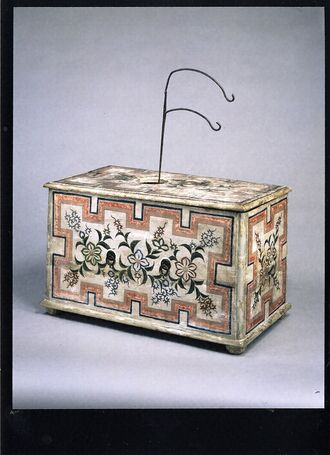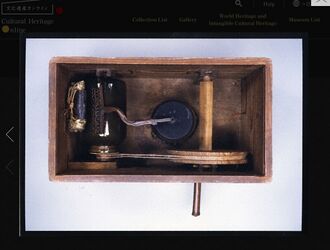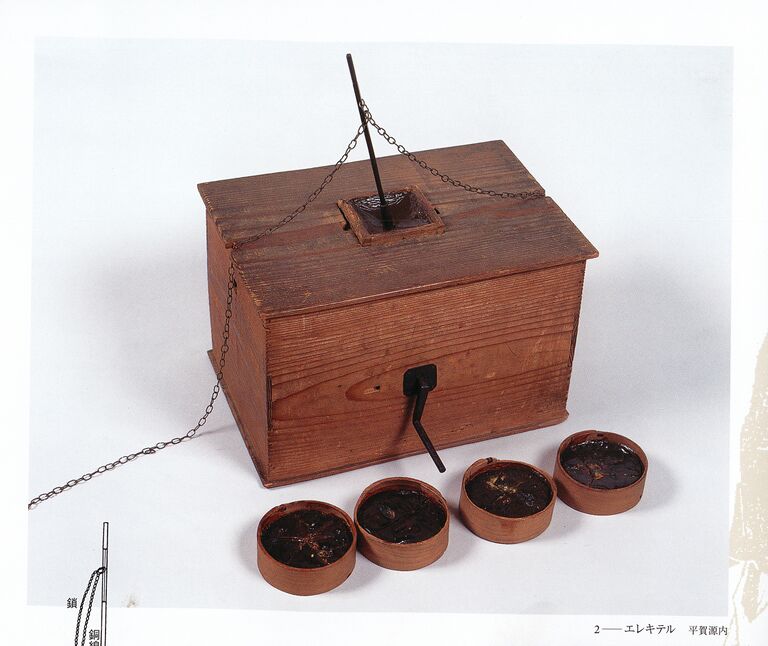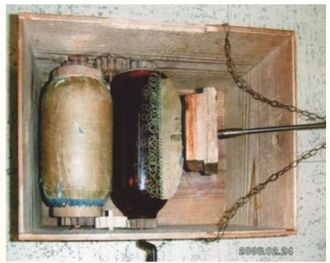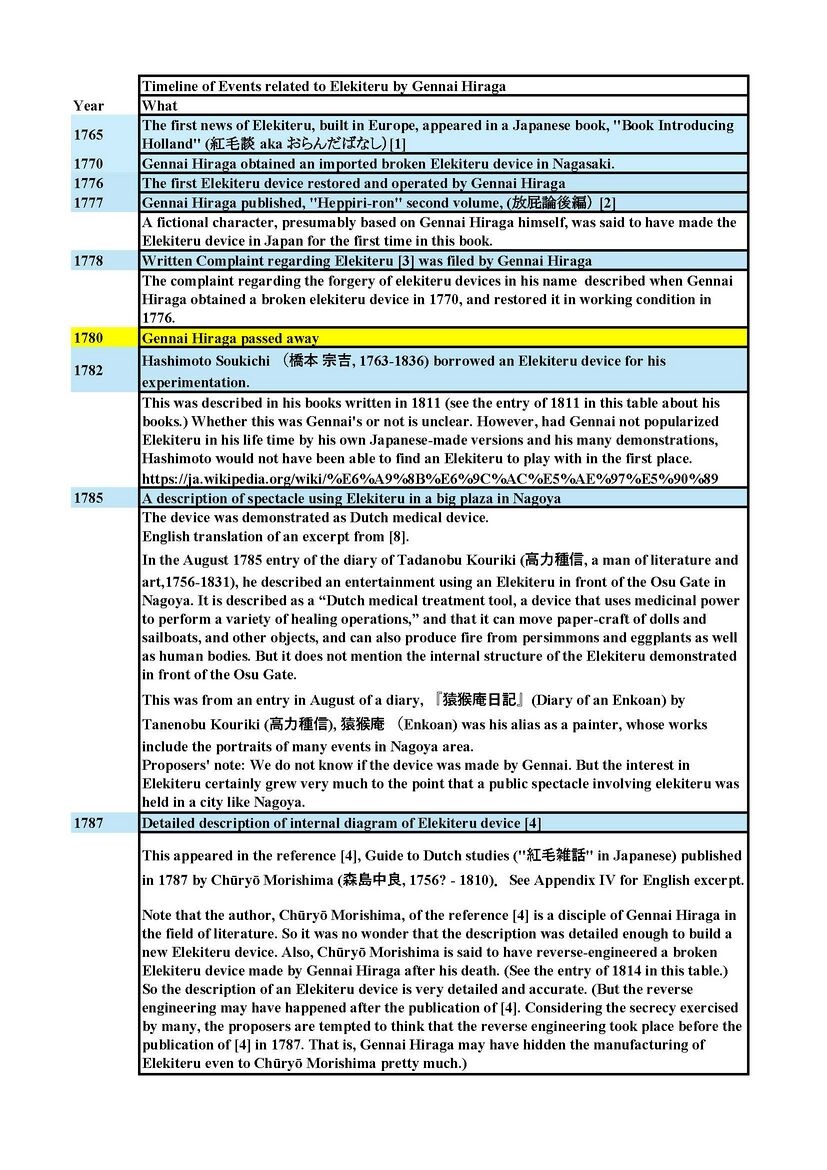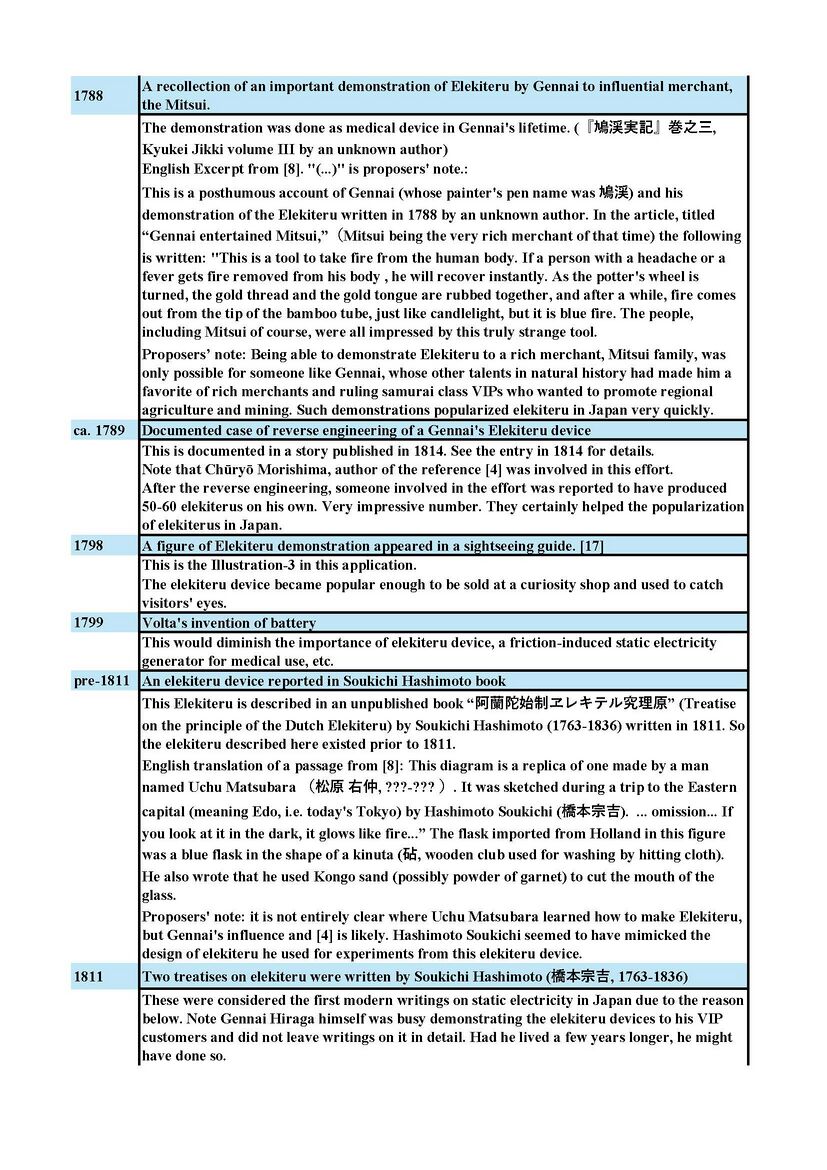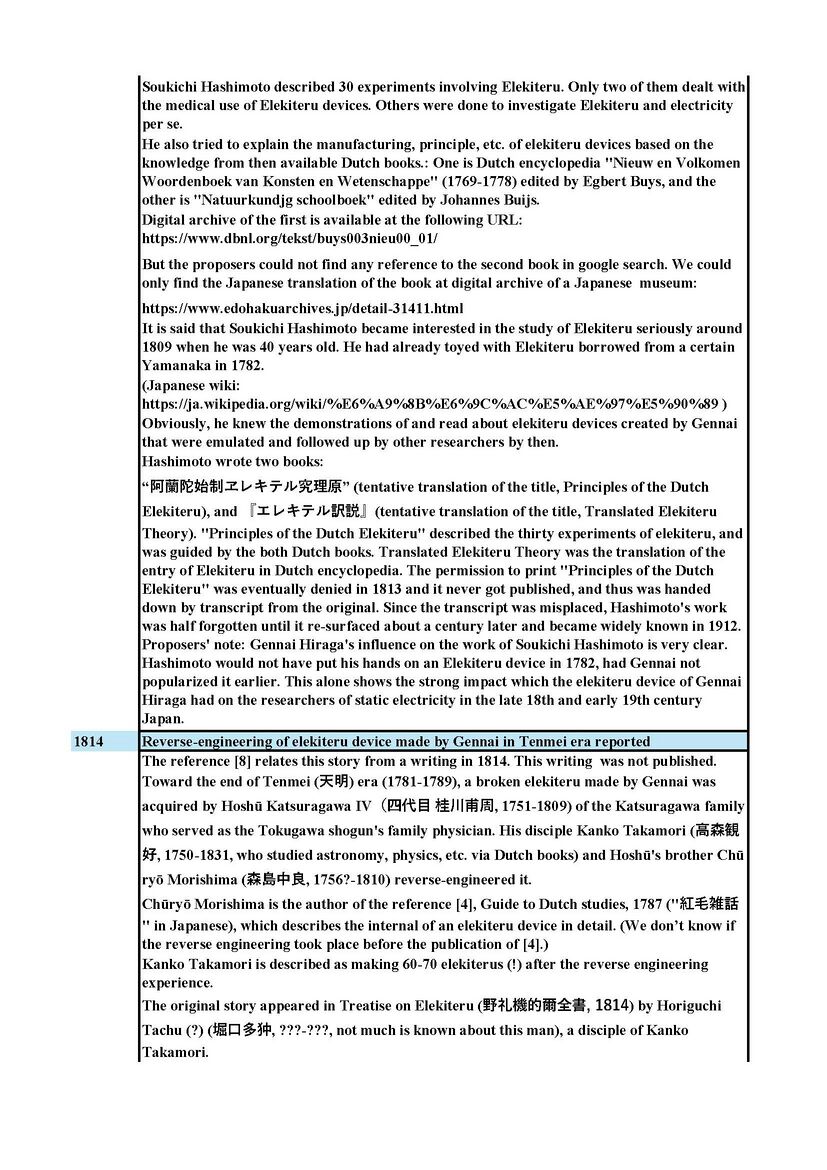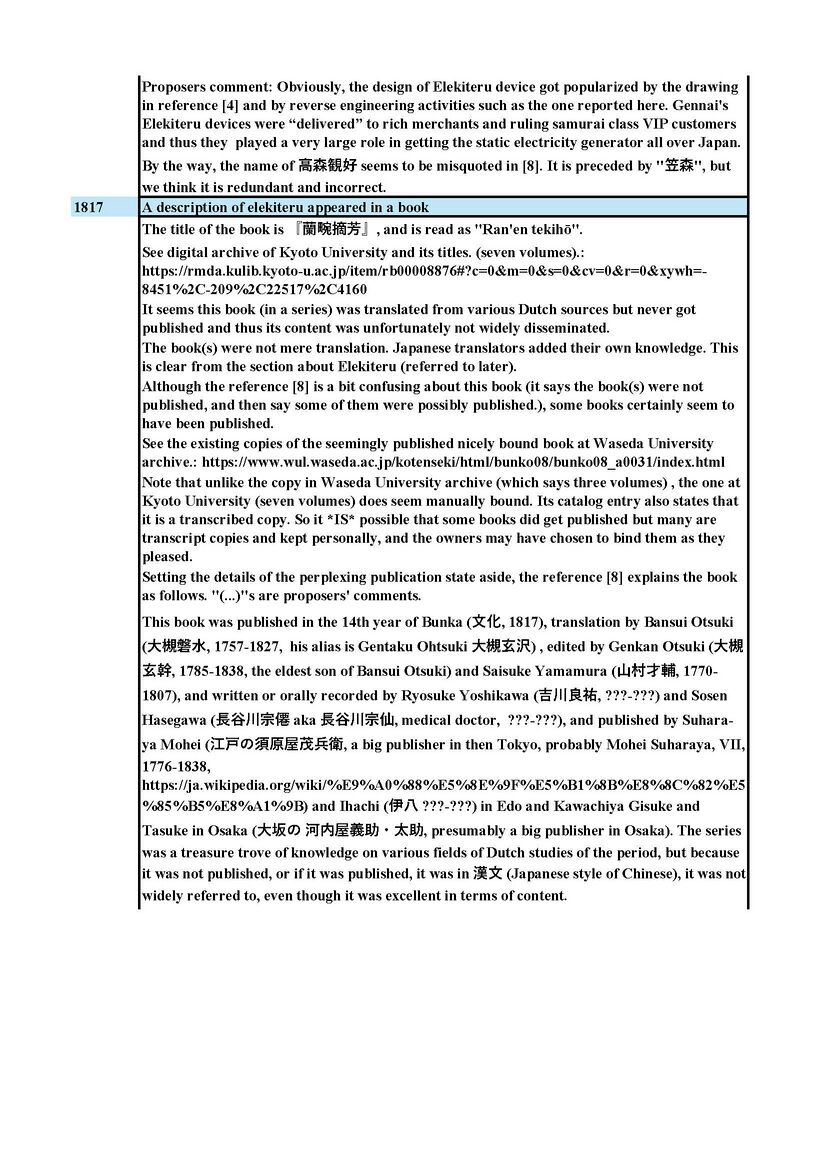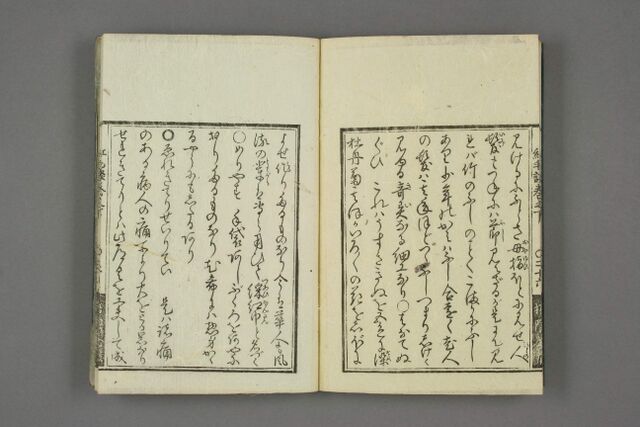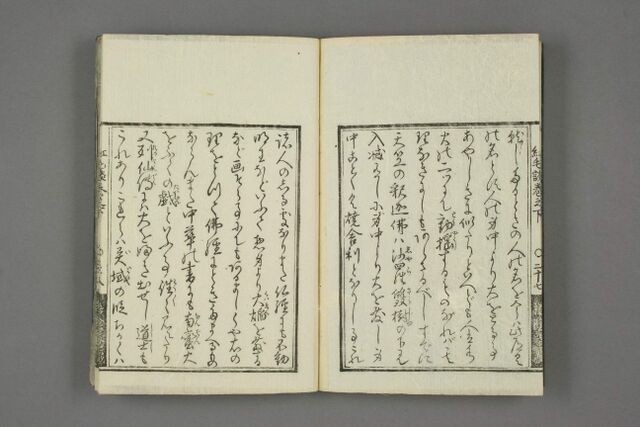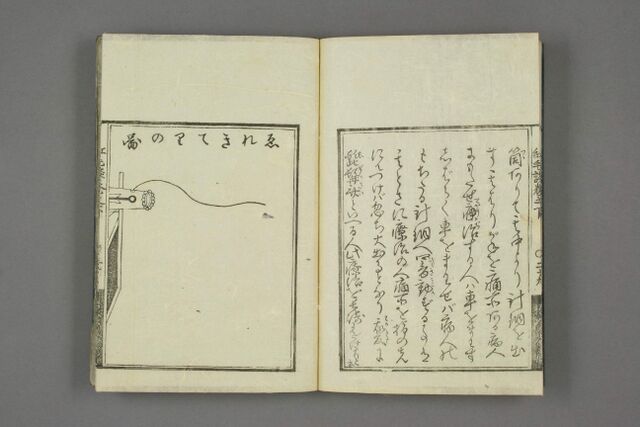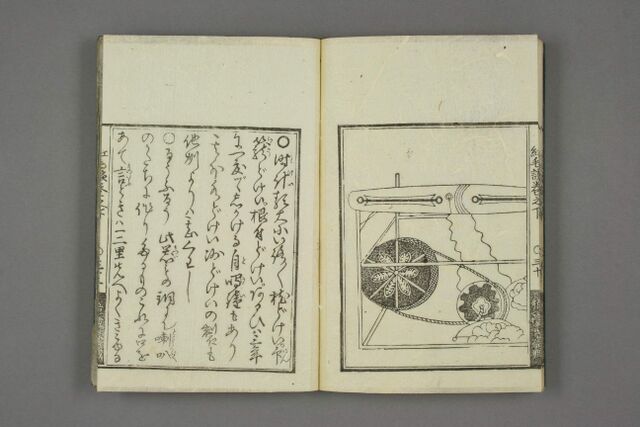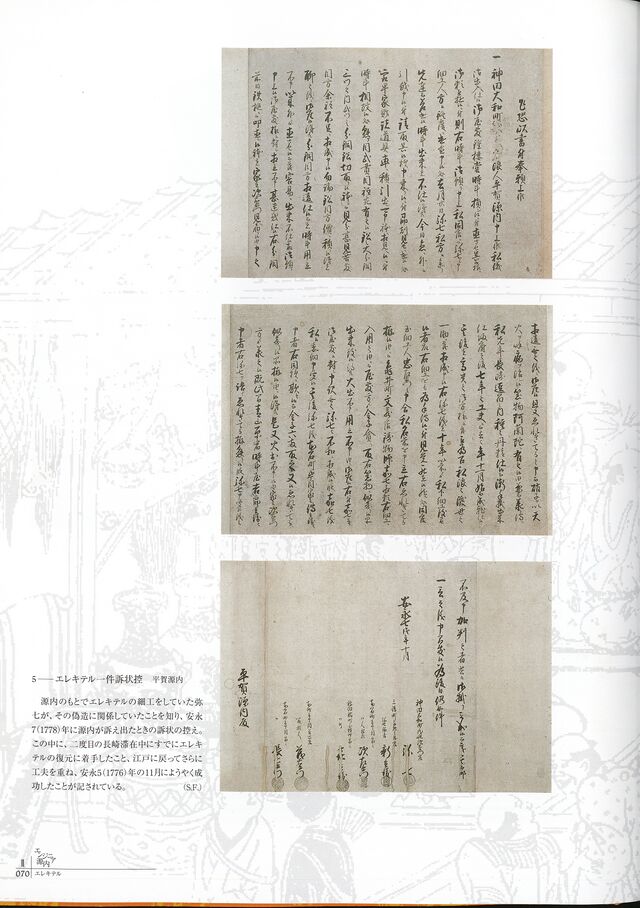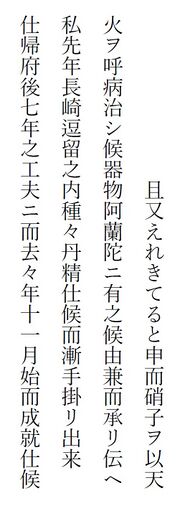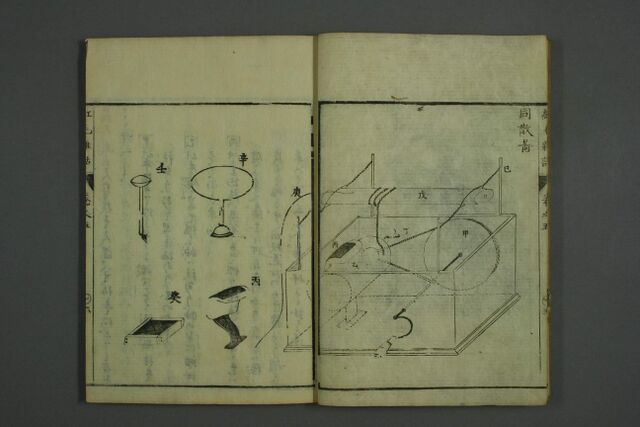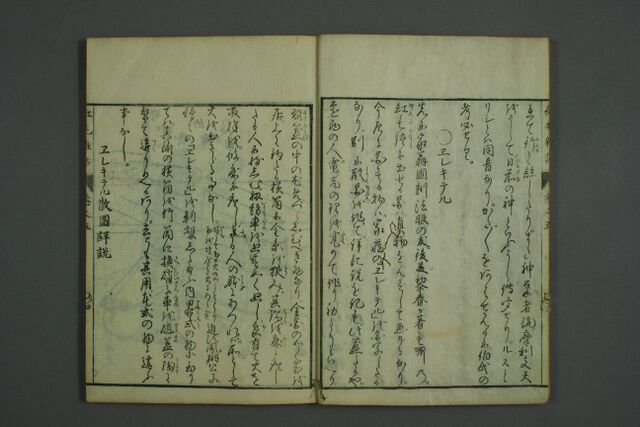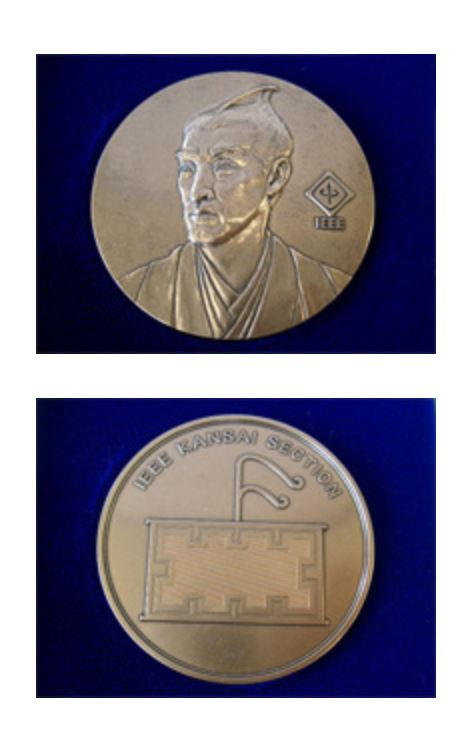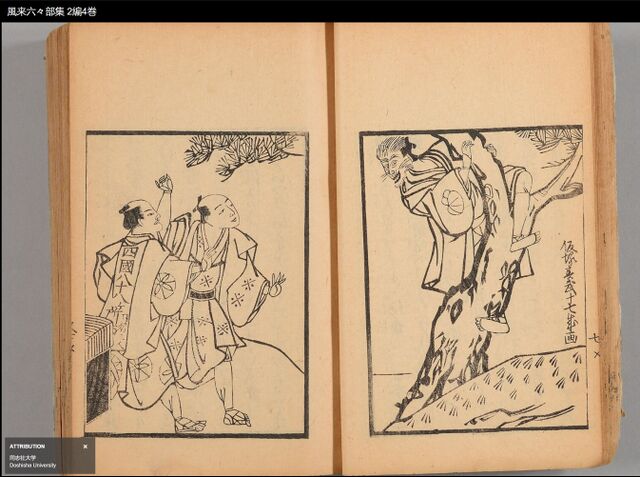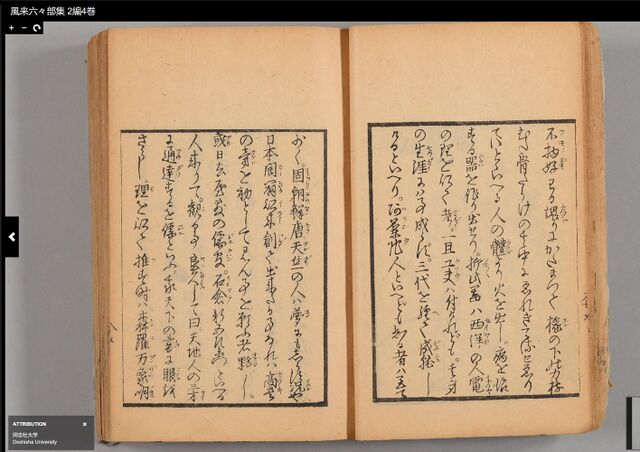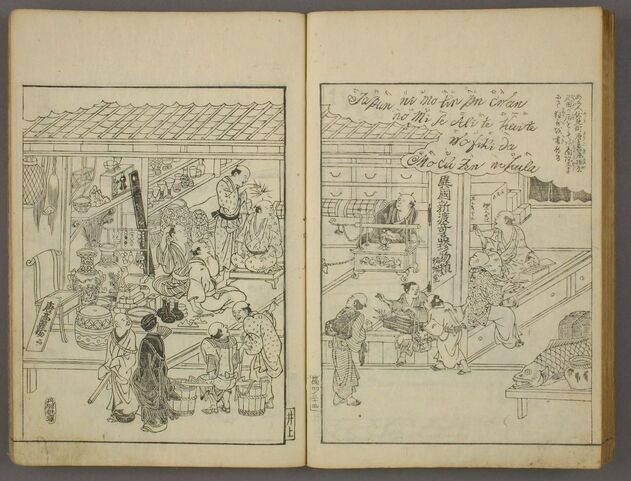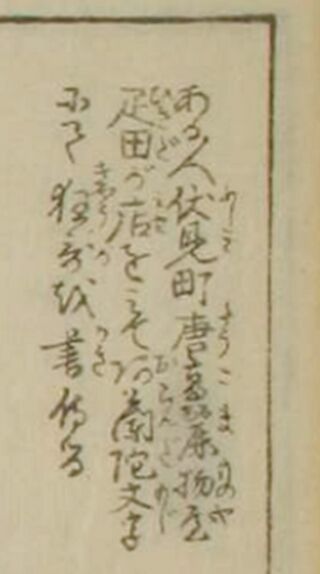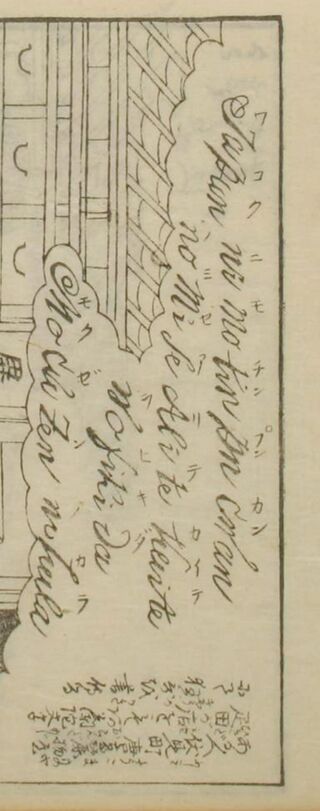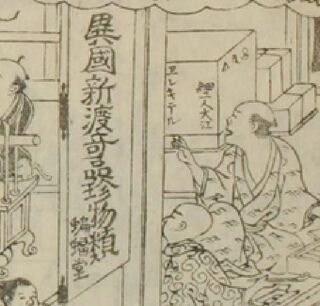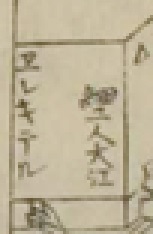Milestone-Proposal:Gennai Hiraga’s Erekiteru: First Electrostatic Generator in Japan, 1776
To see comments, or add a comment to this discussion, click here.
Docket #:2024-16
This Proposal has been approved, and is now a Milestone
To the proposer’s knowledge, is this achievement subject to litigation? No
Is the achievement you are proposing more than 25 years old? Yes
Is the achievement you are proposing within IEEE’s designated fields as defined by IEEE Bylaw I-104.11, namely: Engineering, Computer Sciences and Information Technology, Physical Sciences, Biological and Medical Sciences, Mathematics, Technical Communications, Education, Management, and Law and Policy. Yes
Did the achievement provide a meaningful benefit for humanity? Yes
Was it of at least regional importance? Yes
Has an IEEE Organizational Unit agreed to pay for the milestone plaque(s)? Yes
Has the IEEE Section(s) in which the plaque(s) will be located agreed to arrange the dedication ceremony? Yes
Has the IEEE Section in which the milestone is located agreed to take responsibility for the plaque after it is dedicated? Yes
Has the owner of the site agreed to have it designated as an IEEE Milestone? Yes
Year or range of years in which the achievement occurred:
1776
Title of the proposed milestone:
Elekiteru: First Electrostatic Generator in Japan, 1776
Plaque citation summarizing the achievement and its significance; if personal name(s) are included, such name(s) must follow the achievement itself in the citation wording: Text absolutely limited by plaque dimensions to 70 words; 60 is preferable for aesthetic reasons.
In 1776, a friction-induced electrostatic generator was first demonstrated in Japan by Gennai Hiraga after he spent six years repairing and restoring a broken device imported from the Netherlands. His improved design was later called the Elekiteru, and its widespread demonstration in Japan inspired the country's first generation of electricity researchers. Hiraga's Elekiterus have been displayed in Tokyo and in Kagawa Prefecture, respectively.
200-250 word abstract describing the significance of the technical achievement being proposed, the person(s) involved, historical context, humanitarian and social impact, as well as any possible controversies the advocate might need to review.
During the period of virtual national isolation of Japan in terms of diplomacy, Gennai Hiraga obtained a broken imported electrostatic generator in Nagasaki.
He had spent six years repairing and restoring in Tokyo the first
friction-induced electrostatic generator in Japan when he finally
succeeded in 1776. He used it as a reference to build several such devices which was called Elekiteru, two of which are still in existence. At that time, the Elekiteru was used as a spectacle and medical device.
He did not just repair and restore the original. He improved upon it to create additional Elekiterus on his own.
The older method of spatial insulation by hanging or supporting with a string was improved to using pine resin as insulation material.
Transmitting the rotation of the handle to drive the generator was done originally by tying large and small circular pulleys with a string. Gennai improved it to use wooden gears instead.
Two Elekiteru devices produced by Gennai Hiraga are still in existence.: one at the Postal Museum operated by Japan Post in Tokyo and the other at the Gennai Hiraga Memorial Museum in Kagawa Prefecture. The device in Tokyo has been designated as an important cultural property of Japan by the Japanese government.
The device Gennai Hiraga created in Japan made following
generations of inventors and the curious minded get acquainted with the
behavior of static electricity and get ready to tackle
electrical engineering in a modern setting in the 19th century.
IEEE technical societies and technical councils within whose fields of interest the Milestone proposal resides.
Power Electronics Society
In what IEEE section(s) does it reside?
IEEE Shikoku section
IEEE Organizational Unit(s) which have agreed to sponsor the Milestone:
IEEE Organizational Unit(s) paying for milestone plaque(s):
Unit: IEEE Shikoku Section
Senior Officer Name: Chair: Yuichi Tanji
IEEE Organizational Unit(s) arranging the dedication ceremony:
Unit: IEEE Shikoku Section
Senior Officer Name: Chair: Yuichi Tanji
IEEE section(s) monitoring the plaque(s):
IEEE Section: IEEE Shikoku Section
IEEE Section Chair name: Chair: Yuichi Tanji
Milestone proposer(s):
Proposer name: Chiaki Ishikawa
Proposer email: Proposer's email masked to public
Proposer name: Chozaburo Sunayama
Proposer email: Proposer's email masked to public
Please note: your email address and contact information will be masked on the website for privacy reasons. Only IEEE History Center Staff will be able to view the email address.
Street address(es) and GPS coordinates in decimal form of the intended milestone plaque site(s):
Hiraga Gennai Memorial Museum, 587-1 Shido, Sanuki City, Kagawa, Japan 769-2101
34.323531, 134.174743
Describe briefly the intended site(s) of the milestone plaque(s). The intended site(s) must have a direct connection with the achievement (e.g. where developed, invented, tested, demonstrated, installed, or operated, etc.). A museum where a device or example of the technology is displayed, or the university where the inventor studied, are not, in themselves, sufficient connection for a milestone plaque.
Please give the details of the mounting, i.e. on the outside of the building, in the ground floor entrance hall, on a plinth on the grounds, etc. If visitors to the plaque site will need to go through security, or make an appointment, please give the contact information visitors will need. It is a memorial museum that displays the deeds of Gennai Hiraga. Gennai Hiraga was born nearby and was buried in the neighborhood. No other IEEE Milestone there.
Are the original buildings extant?
N/A
Details of the plaque mounting:
It will be on the museum premises. It will be inside the building where the one of the existing Elekiteru device is displayed currently. Details are still being worked out.
How is the site protected/secured, and in what ways is it accessible to the public?
The museum is a public facility and visited by many visitors each year.
Who is the present owner of the site(s)?
A Public Interest Incorporated Foundation for Gennai Hiraga (tentative English translation) There is a Japanese website of the museum: https://hiragagennai.com/
What is the historical significance of the work (its technological, scientific, or social importance)? If personal names are included in citation, include detailed support at the end of this section preceded by "Justification for Inclusion of Name(s)". (see section 6 of Milestone Guidelines)
Justification of Name-in-Citation
The proposers think the name-in-citation is warranted due to the following observation.
It is clear from the references that Gennai Hiraga repaired and restored an Elekiteru device in 1776 all by himself [3]. This has never been questioned by his contemporaries, existing literature and researchers in Japan over the last two and half a centuries. The creation of multiple Elekiteru devices based on his improvement are clear from the extant Elekiteru devices and description in surviving literature [3],[4].
It is true as evidenced in reference [3] that Gennai Hiraga used some craftsmen to create parts under his instruction to create new Elekiteru devices, but the design of the devices were his. For example, one of the craftsmen who created parts was involved in forgery of devices under Gennai Hiraga's name, but the forged devices failed to produce electricity [3]. This shows the principles of static electricity generation and the importance of insulation for storage of electricity, etc. were only understood by Gennai Hiraga.
His elekiteru devices and the demonstrations ignited the interest of many people. Less than ten years after his death, the demonstration of Elekiteru devices even made it into the shop guide in a sightseeing guidebook of that time. People of scientific bend of the time took notice and many similar devices were created after Gennai Hiraga showed and delivered his devices to rich merchants and ruling Samurai class families. Thus the deeds of Hiraga Gennai, and the Elekiteru devices he created in particular, paved the way of the future research of electricity in 19th century Japan.
His impact on the later generation of researchers are summarized in 4.7 using a timeline table. (It is a bit lengthy and so moved from this Justification of Name-in-Citation section.)
The work of Gennai Hiraga on Elekiteru devices and the impact it had on the later generations of Japanese electrical researchers have been recognized by the Japanese government, domestic academic societies, and the IEEE Japan Council, as shown below.
- In 1915, recognizing the pioneering work, the Postal Museum of Japan, then called Communications Museum managed by then Ministry of Communications of Japanese government, requested the donation of the existing Elekiteru devices from Hiraga family [5]. The museum obtained one of the existing two Elekiteru devices as a result, and has exhibited it ever since.
- The Agency for Cultural Affairs of the Ministry of Education, Culture, Sports, Science and Technology of the Japanese Government examined and designated the Elekiteru device by Gennai Hiraga kept at the Postal Museum as an important cultural property (historical material) on June 30, 1997 [6].
- The National Museum of Nature and Science of Japan has recognized the value of the Elekiteru device by Gennai Hiraga and has made and exhibited a replica of the Elekiteru in the collection of the Postal Museum at its own premises [10].
- Japan Post printed a couple of postage stamps of Gennai Hiraga with his profile on them.: One is a of collector's sheet titled "Science and Technology, Heroes and Heroins of animation No. 6" in 2004, and the other is Kagawa prefecture's stamp sheet that commemorates the 60th anniversary of Local Autonomy Act in 2014.
- The Institute of Electrical Engineers of Japan (IEEJ) examined Elekiteru device by Gennai Hiraga and certified it as the "cornerstone of Electricity" in 2018 [11].
- The IEEE Japan Council highly recognizes the achievements of Gennai Hiraga, the creator of Elekiteru device. They have created a medal made by the Japan Mint with a portrait of Gennai Hiraga and an Elekiteru device on it. The medals have been given to all new promoted IEEE Senior Members since 2020 [12].
The proposers think the referring to Gennai Hiraga's name in the citation is justified due to the reasons above.
Historical Significance
Background
Beginning with the ban on Portuguese ships from entering Japanese ports in 1639 to the conclusion of the Treaty of Friendship between Japan and the United States in 1854, Japan was pretty much of a “closed country” in terms of diplomacy.
This very restricted closed country policy was exercised by then Japanese government under Tokugawa family rule to ban the entry of people from Christian countries other than the Netherlands. China was also exempted, and the Dutch and Chinese boats were allowed to enter only the port of Nagasaki since 1641. Leaving Japan by the Japanese people were prohibited, also. This was a drastic diplomatic measure to control the trade and cultural exchange.
During this period of absence of diplomacy except for the Dutch and the Chinese, Japan became pretty much isolated from the rest of the world. The economy was basically closed only within Japan. The Dutch and Chinese boats which came to Nagasaki and the people aboard these ships were the only window to the rest of the world,
Under such circumstances, Gennai Hiraga used his own insight and ingenuity to repair and restore an Elekiteru device, and created a better design than the original in terms of insulation and mechanical transmission.
Leyden Jar and "Elekiteru" Device in The 18th Century
To put the work of Gennai Hiraga in perspective in the context of global scientific research of the time, here is the quick rundown of electric research that had been done in the rest of the world.
Ancient Greeks knew that amber attracts dust and thread. The Japanese in the 18th century also knew this, and it was even written down in 1765 that people could see sparks occasionally when women comb their hair in the evening [1]. Of course such phenomena must have been known for centuries although not quite written down much.
Systematic study of electricity, however, had to wait until 18th century.
The Leyden jar, a pioneering device in the study of electricity, was developed in the mid-18th century, with Pieter van Musschenbroek playing a crucial role in its invention and subsequent research. In Dutch, Leyden is spelled as Leiden.
Although the Leyden jar was effectively discovered independently around the same time by German cleric Ewald Georg von Kleist and Dutch scientists Pieter van Musschenbroek and Andreas Cunaeus, Musschenbroek's contributions were very important and widely recognized, and thus he was solely credited with the invention for a long time.
Born in 1692, in Leiden, Musschenbroek was a distinguished professor in multiple fields including physics and medicine. His experiments with electrostatics led to the Leyden jar’s creation in 1746, designed to store and release electric charge. However, the notion of electric charge was still in infancy. The invention of Leyden jar allowed researchers to accumulate and preserve electric charge in large quantities, significantly advancing the study of electrostatics.
Following Musschenbroek and Cunaeus's findings, researchers like John Bevis, William Watson, and Benjamin Franklin further explored and refined the Leyden jar, connecting multiple jars to create electrostatic batteries, thereby enhancing the understanding of electrical conduction and storage.
A Leyden jar is essentially a primitive capacitor used to store static electricity. Traditionally, it consists of a glass jar with metal foil coating its inner and outer surfaces, stopping just short of the jar’s mouth to prevent arcing. The foil coatings are separated by the glass, which acts as a dielectric. The inner foil is connected to a metal rod electrode that projects through a non-conductive stopper at the jar’s mouth, typically connected to an external power source like an electrostatic generator. The charge is stored between the inner foil and the outer foil, which is usually grounded. Early versions of the Leyden jar used water as the inner conductive material, but this was later replaced with metal foil for greater efficiency. Leyden jars that used air as the insulating separator were created, which confused people, including Benjamin Franklin, who thought glass was essential in storing electric charge.
Thus, the jar was fundamental in early electrostatic experiments and played a crucial role in the development of modern capacitors, marking a significant milestone in the history of study of electricity.
With this historical background, it is natural to find a combination of Leyden jar or an equivalent charging storage (possibly a human body) and electrostatic generator in mid-18th century Europe. (However, the proposers are aware that many similar devices kept the charge storage OUTSIDE the box of generator whereas Gennai stored the Leyden jar INSIDE the generator at least in one of his existing devices.)
The description of such a combination is found in the Japanese reference published in 1765 [1] which Gennai Hiraga is believed to have read. (The translation of the excerpt of the relevant part of the reference [1] is in Appendix I. From it, we can learn the general knowledge of electricity or the lack thereof in Gennai's time rather well.)
Elekiteru by Gennai Hiraga
Elekiteru is the name of a generator of static electricity caused by friction, which was repaired and restored by the naturalist Gennai Hiraga (1728-1780) in working condition for the first time in Japan in 1776 [1]. Note: He is considered as a man of many talents. His knowledge of the natural history such as plants and minerals helped him to have good connections with rich merchants in Tokyo (then called Edo) and Osaka and ruling class samurai people in many corners of Japan including Tokyo. He was also a man of literature and wrote many books. His business and political connections helped the popularization of his elekiteru devices. In this application document, we will focus only on his research on elekiteru.
cf. Some references describe his death to be in the year 1779 while the proposers has adopted 1780 as the year when Gennai Hiraga passed away. There is some confusion because of the following situation. Gennai Hiraga passed away on December 18, 8th year of An'ei (安永) era according to the mainstream opinion. But this date was expressed in then current Japanese lunar calendar. The same date is January 24, 1780 in the Gregorian calendar. That is, the 8th year of An'ei overlapped the Gregorian year 1779 very much. But the last month of 8th year of An'ei spilled over to the year 1780, and Gennai Hiraga passed away in the 1780 portion. In some references, his birth year is also reported to be one year off from the one adopted by the proposers, which the wikipedia has adopted also. Such differences are likely to be due to the misconversion between the old Japanese lunar calendar and Gregorian calendar, and to the particular month in which an event took place in the Japanese lunar calendar system (as in the case of Gennai's passing year). This application tries to stick to the year 1780 as the year of his death. But we left the dates in various references as they appear in the original.
The name Elekiteru was derived from the Dutch (Latin) word "elektriciteit".
In one of his writings, Gennai Hiraga himself referred to it as "ゑれきてるせゑりていと" in classical Japanese hiragana script, which is read
something like “Erekiteruseeriteto" in the reference [2] (published in 1777).
The news of Elekiteru-like device, developed in Europe, first appeared in Japan in 1765. It was in
Rishun Goto's "Book introducing Holland" [1].
It is believed Gennai Hiraga read the book. After reading it, Gennai Hiraga acquired a damaged Elekiteru device in 1770 during his stay in Nagasaki according to the reference [3] written in 1778. Where he obtained the damaged device is generally assumed to be from an interpreter for the Dutch, Zenzaburō Nishi. Six years after he obtained the damaged Elekiteru, he succeeded in repairing and restoring it in 1776 [3].
- Note: Gennai Hiraga claimed he spent "seven" years, not "six". But the duration calculated from the historical recording is more likely to be six (6) years. The discrepancy is examined in the proposers comment, note 2, in the reference [3]. The proposers have adopted six years as the duration he spent.
The circumference evidence and sporadic documentary evidence suggest that he produced some Elekiteru devices of his own new improved designs circa 1777.
Two of them which were said to have been made by Gennai Hiraga according the Hiraga family lore are still in existence as explained in this application document.
In Japan as well as overseas, Elekiteru devices were used as a spectacle and medical device at that time [4].
Understanding of Static Electricity by Gennai Hiraga
The year 1770 when Gennai Hiraga obtained a non-working Elekiteru is 24 years after the invention of Leyden jar in 1746 and 18 years after the kite experiment conducted by the American scientist Benjamin Franklin in 1752, and it is possible that the information about these earlier developments were available to Gennai Hiraga via Dutch books. (See [1] published in 1765, for example.) However, considering the era in which Gennai Hiraga lived and the country's virtual isolation from the rest of the world except for the Netherlands and China, he might not have a systematic knowledge of static electricity which contemporary people in Europe and elsewhere might have had.
It is easily imagined that Gennai Hiraga acquired knowledge of static electricity while making his own improved version of Elekiteru, albeit in fragments. For example, he was aware of the importance of insulation and used resin for this purpose extensively. He coated the wooden gears for mechanical rotation with resin. The abundance of the resin used is clear in the photo 3 in later this document.
Gennai Hiraga explained the principle of electricity generation with yin-yang theory and Buddhist fire monism in the reference [2] published in 1777 in a jokingly manner. To be honest, it is hard to tell whether he was serious or not. He wrote the reference [2], a fiction about a strange man who made Elekiteru device on his own, in a very satirical manner. Although we do not want to clutter up the main application document with quotes from 18th century literature, this book is the only material that suggests what Gennai Hiraga thought of electricity. So, here is the English translation of the relevant part of [2].
The person sticks to his role in his affiliation (*1), and it is said he himself knows that he is a fool who does not understand his skill and limit well. But there’s no accounting for taste.(*2) His tendency to like curious things (*3) has become very solid. Although he makes fruitless effort (*4) which are not appreciated much (*5) by his contemporaries, he developed a device that extracts fire from human body and cures sickness. This device is said to have been developed by westerners who thought about the physics of lightning. However, although a promising attempt was made, it could not be made in one’s lifetime. It took three generations to complete the device according to a legend. Even among the Dutch, there are very few people who know this device. And people in Korea, China and India (*6) do not know about this at all. In Japan, this is the first such device in its history, and thus there are very large number of people in the noble circles who want to see this for the first time. from the second part of Houhi-ron 『放屁論後編』 by Fūrai Sanjin 風来山人 (The original pages in digital photos are in quoted in the bibliography section. The numbered notes are explained in Appendix II).
He knew that if he held the similarly placed electrodes from two Elekiteru devices, he would not get electric shock. Furthermore, ♂, the symbol of "Mars" (meaning plus) and ♀, the symbol "Venus" (meaning minus) were drawn on the top lid of the existing Elekiteru device which is now kept at Postal Museum. This suggests that Gennai Hiraga may have been aware of the polarities of charges.
He referred to the sparks generated by the Elekiteru device as occurring on "the principle of lightning" [2]. So, it seems that he shared the same knowledge and view with Benjamin Franklin that the sparks produced by Elekiteru device and lightning are caused by the same physical principle. But to think he had a good knowledge is very premature, and misguided in the proposers' opinion. We need to wait for the 19th century researchers to have deeper understanding. Still his pioneering work on Elekiteru that ignited the interest in static electricity should not be underrated.
Elekiteru devices made by Gennai Hiraga in existence
Two Elekiteru devices that are said to have been made by Gennai Hiraga according to Hiraga family lore are still in existence. The Hiraga family donated one of the devices to the Postal Museum (then called Communications Museum) of Japan in 1915 [5]. The donation was prompted by the request from the museum and mediated by then Kagawa prefecture governor. Actually two devices were donated to the museum initially. However, the museum sent back a unit to Hiraga Family and asked for its keeping because the museum felt having both devices at the museum in Tokyo was not a good idea in case of natural disasters and other mishaps. During the bombing raids over Tokyo in World War II, the device at the Postal Museum was sent to the countryside for protection.
Collection at Postal Museum
This "Elekiteru (Hiraga family heirloom)" was designated as an important cultural property (historical material) by the Japanese government in 1996 [6].
The features of this device are as follows.
- It is equipped with a Leyden jar (or Leyden bottle) for storing electricity.
- The enclosure is made of a wooden box and has floral illustration on it. On the top lid, ♂, the symbol of "Mars" (meaning plus) and ♀, the symbol of "Venus" (meaning minus) are drawn.
- The mechanism to transmit the rotation of the handle is a string wrapped around a couple of circular pulleys.
Photo 1 shows the exterior and Photo 2 shows the interior.
Photo 1: Quoted from: https://www.postalmuseum.jp/collection/genre/detail-133313.html
Photo 2: Quoted from: https://bunka.nii.ac.jp/heritages/detail/212233
Illustration-1
Internal schematics of the device. From: Figure 1 of reference [14]
Collection at Hiraga Gennai Memorial Museum
The second device is still the property of the Hiraga family [7]. The features of this device are as follows.
- This Elekiteru device does not have a Leiden jar. Therefore, there are following two theories about how to use it.
- There was originally a Leiden jar because there is a space inside, or
- The human body was used as an electricity storage device because four wooden vases that contain insulating pine resin used for the feet of the pedestal on which a person would sit are still extant (see Photo 3), and such usage is seen in later drawings of how Elekiteru device was used for demonstration (See Illustration-2, for example in the reference [4] published in 1787.
- The enclosure is made of a wooden box, but has no decoration.
- The mechanism that transmits the rotation of the handle uses wooden gears, and pine resin coating was applied for insulation purposes on the wooden gears.
- It uses three wooden gears to make the cylindrical pillow and the glass bottle rotate against each other on the contact surface, and the sum of the rotational speeds of these cylindrical surfaces causes friction [9].
This unit is considered to have been made later than the Elekiteru
device at Postal Museum since the above-mentioned gear rotation
mechanism and pine resin insulation method were adopted and it is
presumed that Gennai Hiraga devised them.
Photo 3: Exterior of the device at Hiraga Gennai Memorial Museum, taken from an exhibit catalog [13]
[Caption] The resin used for insulation is clearly visible. (You can enlarge the picture by visiting the uploaded file by clicking on the photo.) The four wooden containers in the front are filled with resin. They were used to insulate the chair/pedestal, on which a human subject sat, from the floor. Their usage is depicted in Illustration-2 in the following.
Photo 4: Interior of the device, from reference "Elekiter and Mr. Gennai Hiraga" [11]
Illustration-2
Quoted from reference [4] published in 1787, available at Waseda University archive. https://archive.wul.waseda.ac.jp/kosho/wo07/wo07_01526/wo07_01526_0005/wo07_01526_0005_p0006.jpg
[Illustration] A picture of a person sitting on a pedestal whose feet
were placed on vases filled with pine resin to insulate the body from the
floor during charging. He is being treated with electricity from Elekiteru device.
The human body itself stored the electric charge generated by the
Elekiteru device instead of a Leyden jar.
When something touched the body, a spark was generated.
The person on the far left is said to be Gennai Hiraga [4].
Popularity of Elekiteru Device after the death of Gennai Hiraga
After his untimely death in 1780, a somewhat detailed internal diagram of an Elekiteru device appeared in reference [4] in 1787 already.
The unique design of Elekiteru by Gennai Hiraga was picked up by later generation in Japan. He demonstrated and delivered his devices to rich merchants and ruling class samurai families.
It is not quite clear whether he "sold" the device per se. It was more like a part of a larger consultation service which Gennai Hiraga offered to these people. In his time, there was very strict social class system which distinguishes the ruling samurai class, merchants, craftsmen, and farmers. Gennai was part of the samurai class, and "selling" something, which was "relegated" to merchant class, was not deemed proper for his ruling samurai class.
He had connection with these influential
people thanks to his successful execution of trade exhibitions where
his knowledge of natural history on plants and minerals were useful
for promotion of regional goods and economy.
It was obvious that his devices were emulated by many through the
demonstration of devices at the request of influential people in
business and political quarters, and eventual delivery of such devices
where they were requested.
The elekiteru devices became very popular in Japan, and they were used as a
spectacle at a gathering or for medical purposes.
The following illustration in the reference [17] published in 1796-1798 shows such usage of an Elekiteru device
at a curiosity shop. The reference [17] is a sightseeing guide.
The Japanese word for "Elekiteru" is visible in a name plate in the
drawing.
Illustration 3

Taken from reference [17] published in 1796-1798.
[Illustration caption] An elekiteru device is on the right page and is
connected via wire to the
person sitting on a pedestal with four legs on the left page.
There is a spark flying on the man's head where another man places his finger.
People around the scene were amused to watch the spectacle.
(See Appendix IX for details about the Japanese phrases in the illustration.)
The impact of Elekiteru: Legacy of Gennai Hiraga
The device Gennai Hiraga created in Japan made following generations of inventors and curious minded get acquainted with the behavior of static electricity and get ready to tackle electrical engineering in a modern setting in the 19th century. Such development by the later generation is detailed in the reference [8]. Authors of the reference [8] studied the history of elekiteru devices after the death of Gennai Hiraga and commented on how Gennai's design (improved insulation) was adopted by later generation for the purpose of demonstration and more importantly for the early study of electricity in Japan.
Timeline of elekiterus and others after Gennai's death in 1780
Here is the timeline of elekiterus appearing in the Japanese literature to show the impact of Gennai's elekiteru had in Japan in the last part of 18th century and the beginning of 19th century on the study of static electricity.
Words of caution.
First of all, please bear in mind that, in the time of Gennai, publishing a book required the permission from then ruling Tokugawa government. Some of the books referred in the reference [8] and summarized here never got officially published and known to this day only because somebody transcribed the original by hand. The reference [1] was published, but then immediately banned and its woodblocks for printing destroyed. Thus only small number of copies exist today.
Printing a book in Gennai's time was a very labor-intensive operation and thus, there were few books on technology like Elekiteru to begin with.
Some books referred in [8] are omitted because their publication dates are not very clear for the purpose of this application document. Japanese titles of books that do not appear in the REFERENCES section are left in the table.
Also, it is not easy for the proposers to access the sources mentioned in [8] because they were published more than 200 years ago. Some were transcribed and said to be only held by someone personally. So the proposers have to rely on [8] and other sources such as wiki and digital archives of the books to verify informally what was said in [8] more or less.
To give the sense of history, the known years of birth and death of the person mentioned in the table is given. "???" is given when it is not known.
Another word of caution. The table became long because
- simply saying something happened in a certain year does not make sense for the purpose of explaining the impact of Gennai's deed on the later generation.
- First of all, we have to show that the evidence of the event based on some documents.
- Secondly, we have to explain the significance of the event one way or the other.
The proposers hate to make the main text long, but the long table seems unavoidable, especially because the lengthy explanation is in order for non-Japanese readers to understand the timeline and the atmosphere of the late 18th and early 19th century Japan as far as elekiteru development was concerned.
From the summarized table below which includes some knowledge the proposers culled from sources other than [8], the readers can see the knowledge of Elekiteru devices got popularized rather quickly after Gennai's death in 1780 despite scarcity of books. The interest in the device caused creation of similar devices and experiments. The detailed inner diagram of an Elekiteru device in the reference [4] published in 1787 seemed crucial in getting the enough knowledge to build an Elekiteru device all over Japan. Even a reverse-engineering effort of Gennai's device was documented. One of the persons involved in the reverse-engineering effort was said to have produced 50-60 Elekiteru devices. (See the entry in circa 1789 and 1814.)
As can be seen from the table below, Gennai's work had profound impact on the initial phase of study of static electricity in Japan culminating in the work of Soukichi Hashimoto in 1811, which mentioned 30 experiments involving elekiteru device. At the same time, the readers can see that the study of more advanced topic of electromagnetism in 19th century lagged in Japan until modern universities were created in 1877. Not much was done after Elekiteru devices got popular in Japan. This was partially due to the virtually closed country policy. Because of this observation, the proposers regard Gennai Hiraga's persistence in restoring and improving Elekiteru device alone in late 18th century is remarkable.
We can only guess how the rapid communication among the scientifically-inclined in the period took place after Gennai's death although the word for science (科学 pronounced as kagaku) was not used with such meaning in Japan yet. This quick propagation of the knowledge of elekiteru happened despite the secrecy kept among the inventors of the time. In Japan, it was customary that knowledge learned by a scholar or craftsman was handed down only to the eldest son or the eldest and ablest disciple, and not published at all. Quite contrary to what science in 20th and 21st century is all about.
The proposers think that the publication of [4] in 1787 that detailed innards of elekiteru by a disciple of Hiraga Gennai made such secrecy irrelevant as far as the basic principle and manufacturing of Elekiteru device were concerned. Thus, the rapid adoption of Elekiteru device by many in a short time took place.
Timeline Table. (The proposers could not create a table using wiki formatting very well on IEEE Wiki site, so instead opted to create a table in spreadsheet and attach the output from it.) For searchable document, we attach PDF. For just viewing, we attach JPEG output pages from PDF.
Timeline of Events after Gennai
PDF:
File:Timeline-of-events-after-Gennai-rev03.pdf
The impact of Elekiteru today
Thus Elekiteru device by Gennai Hiraga made a very important contribution to the development of electrical engineering in 19th century Japan.
To this day, the curiosity in Elekiteru device in Japan is so strong that a model kit of Elekiteru device which you can use to experiment with static electricity has been created and sold in Japan. The latest such kit the proposers could find in the general market was sold in 2008 and still can be purchased second hand on the Japanese Amazon.com (https://www.amazon.co.jp/exec/obidos/ASIN/4056053561/)
His influence on the student of electromagnetism and electrical
engineering and popular culture in Japan has been immense and Gennai
Hiraga certainly left a clear footprint.
Interest in Gennai Hiraga among the general population has been
constantly strong.
He was the main character in an
nation-wide TV channel's history drama in 1971-1972 called Tenka Gomen
(天下御免). NHK's
website: https://www2.nhk.or.jp/archives/movies/?id=D0009010167_00000
He also became the focus of a museum exhibit [13], Gennai Hiraga Exhibit
2003-2004 at Edo-Tokyo Museum.
We get to read new books on him from time to time even today.
Search in amazon turns up the following. The latest one seems to be
from the last year (2023).
https://www.amazon.co.jp/s?k=%E5%B9%B3%E8%B3%80%E6%BA%90%E5%86%85
What obstacles (technical, political, geographic) needed to be overcome?
Obstacles to Overcome
Difficulties in obtaining information from overseas
At the time when Gennai Hiraga created his own Elekiteru device, Japan was virtually isolated from the rest of the world except for the Netherland and China. In other words, there was no information from other countries, and he was almost isolated scientifically.
The culture and prevailing knowledge of the world including the West, could only be obtained through trade with the Netherlands and China. Moreover, the contact point with the foreign boats was limited to the port of Nagasaki.
Gennai Hiraga could only learn Western knowledge from books written in Dutch and their translations. Therefore, Gennai Hiraga overcame the difficulties of repairing and restoring the original Elekiteru device with the techniques handed down in Japan and his own ingenuity.
Note that the ordinary Dutch people who came to Japan did not know the operation of friction-induced static electricity generator, not to mention its principle. Gennai mentioned in the reference [2] that there were only very few Dutch people who knew about it. Obviously he tried to learn how the damaged Elekiteru device was supposed to work, but could not learn it from the Dutch traders, sailors and officers of Dutch boats in Nagasaki during his stay. He seems to have talked to Chinese traders, sailors and officer as well, but to no avail at all.
Lack of understanding of static electricity
The following points are described previously in the section "Understanding of Static Electricity by Gennai Hiraga ", but is repeated for completeness’s sake.
The year 1770 when Gennai Hiraga obtained a non-working Elekiteru is 24 years after the invention of Leyden jar in 1746 and almost 20 years after the kite experiment conducted by the American scientist Benjamin Franklin in 1752, and it is possible that the information about these earlier developments were available to Gennai Hiraga. (See [1] for example.) However, considering the era in which Gennai Hiraga lived and the country's virtual isolation from the rest of the world except for the Netherland and China, he did not have a systematic knowledge of static electricity which contemporary people in Europe and elsewhere might have had.
It is easily imagined that Gennai Hiraga acquired knowledge of static electricity while making his own improved version of Elekiteru, albeit in fragments. For example, he was aware of the importance of insulation and used resin for this purpose extensively. He coated the wooden gears for mechanical rotation with resin.
References [8] and [18] discusses reconstructions of Elekiteru devices in the 21st century. Even with the understanding of electromagnetism in the 21st century, the behavior of friction-based static electricity generator is affected by many factors such as the humidity of the ambient air, the rubbing force and speed of two objects to generate the electricity, and the insulation of the box or the human body, and the authors of [8] and [18] had tough time to create static electricity initially. It is easy to imagine that Gennai Hiraga had much tougher time before the first spark was created with his Elekiteru.
What features set this work apart from similar achievements?
Features that set apart this from others
The first Elekiteru in Japan
Gennai Hiraga lived during the period of Japan's virtual isolation, so the knowledge obtained was limited to a few books written in Dutch [1]. Material supplies available from abroad were also limited. Under such difficult circumstances, he obtained a broken Elekiteru [3]. Then, with ingenuity to supplement the fragmentary knowledge, he repaired and restored it over a period of seven years [3]. (Note that, although Gennai himself used "seven years" to describe his long duration of work in [3], it is more likely to be "six years". So the citation uses "six years" instead. See the cautionary note in the bibliographic listing of the reference of [3].) At that time, there were no devices in Japan that generated static electricity using friction, as far as the existing literature is consulted.
Improved insulation methods
The success of an friction-induced static electricity generator depends on the insulation method used. Gennai Hiraga made efforts to improve the insulation method [8].
The conventional method was to hang or support a generator and/or electric storage body (Leyden jar or human) in space with a string to insulate it [1]. For example, reference [8] has a figure from a German museum in which a person was supported aloft using ropes from above to charge electricity from a friction-induced static electricity generator. The early Elekiteru device produced by Gennai Hiraga used this method to physically support the electricity storage bottle, too [5].
However, the later Elekiteru devices made by Gennai Hiraga used the method of insulating such bodies from the enclosure or floor surface with pine resin. Even with this improvement, the very humid rainy season in Japan made it difficult for him to produce static electricity reliably[8].
Improvement of drive transmission method
Gennai Hiraga improved the method of transmitting the rotation of the handle to drive the generator [9].
The conventional method was to use a string on two round disk-shaped pulleys, one large and one small, and transmit the rotation of the handle to the generator [1]. And the early Elekiteru produced by Gennai Hiraga used this method [5].
However, the later Elekiteru created by Gennai Hiraga used the method of transmitting the rotation with a combination of wooden gears. This made it possible to generate electricity in a stable and efficient manner.
Wooden gears were very popular in Japan during Gennai Hiraga's time. They were often used in so called Karakuri Ningyō (Mechanical Dolls) of the time [15],[16]. They were carefully crafted autonomous robots. It is easy to see the utility of wooden gears over pulleys and string to generate electricity reliably. Gears would not slip under heavy load at all. Metal gears might have proven unfit due to its conductivity. They might have turned out to be an unwanted electric pathway from the viewpoint of insulation. Wooden gear is better for this purpose. Gennai Hiraga coated the wooden gears in resin for additional insulation. He was definitely aware of the importance of insulation.
Why was the achievement successful and impactful? Supporting texts and citations to establish the dates, location, and importance of the achievement: Minimum of five (5), but as many as needed to support the milestone, such as patents, contemporary newspaper articles, journal articles, or chapters in scholarly books. 'Scholarly' is defined as peer-reviewed, with references, and published. You must supply the texts or excerpts themselves, not just the references. At least one of the references must be from a scholarly book or journal article. All supporting materials must be in English, or accompanied by an English translation.
Note on the References
Proposers are very much aware of Milestone's Proposal guidelines. In writing this Proposal, the proposers attempted to adhere to those guidelines. However, there were some serious difficulties in introducing and translating documents from the 18th century Japan.
① In Japan, people's names are usually written by their surname first and their name last. However, in this application submission, where we wrote the names ourselves, we used the English-style order of given name and surname. We took care when translating 18th century texts or contemporary references into English, but there may be places where the order of names is reversed from the English order. Please keep this in mind. Also, please note that the names of important people in the quotations translated into English are accompanied with English wiki entries as references, but all of these 18th century Japanese names are referred to in the English wiki in the order of surname first and given name last, i.e., using the Japanese customs. Quite confusing, but we could not avoid it.
② Japanese names are usually written in kanji characters. However, kanji can be read in several different ways, and the same sequence of kanji characters can have different readings.
Names of people in the 18th century were no exceptions. There are many possible readings for their names. The problem is that no one is certain how a person's name was read at the time, and different scholars have different adopted readings. Furthermore, some people seem to have accepted more than one way to call them.
For example, there is the name 森島中良 Morishima Chūryō. (森島 is family name and 中良 is given name.), the author of the reference [4]. He is a disciple of Gennai Hiraga and thus appears in the references. The widely accepted reading of his name is Morishima Chūryō. (see his wiki entry: https://en.wikipedia.org/wiki/Morishima_Ch%C5%ABry%C5%8D)
However, it is not impossible to read 中良 differently. For example, the reference [8] deliberately reads it as Nakara (なから).
What should the proposers do?
The proposers are not that much concerned about the reading.
What is important is whether the name written in kanjis can be used to identify a specific person, and scholars and people who read the name in various ways agree on that. For example, regardless of the reading, 森島中良 can be identified as a disciple of Gennai.
Therefore, we say that the romanization of 18th century names in this application document has no essential meaning. What is reliable is the original name written in kanji and sometimes in kana in addition.
The romanization of personal names used here may not be consistent
with the intent of the authors of each referenced document. However,
that has nothing to do with the historical importance of Elekiteru
devices of Gennai Hiraga for the purpose of this application document.
The English translation here is not meant for a historical study in
depth, but merely a supplementary document to show Gennai Hiraga's
achievements in the history of electricity study and its development.
Those who wish to discuss the notation or reading of names in the 18th century are welcome to take time to do so.
Note there are a few different systems for transcribing Japanese
sound using roman alphabets today. See, for example,
https://en.wikipedia.org/wiki/Romanization_of_Japanese
This complicates the topic of name
rendition using Roman alphabets still further. Even if two scholars
agree that a certain name is read in the same manner, they may render
it using different roman letter sequences.
③ For the 18th century references [1], [2], [4], [16], the original books were woodblock printed. That is, the text is engraved on the woodblocks and printed on handmade Japanese paper with black ink. These old books are now stored carefully by their owners to prevent deterioration over time. Therefore, ordinary people including the proposers cannot easily see the originals. Therefore, in writing this proposal document, the proposers viewed the relevant pages through photographs available at the Gennai Memorial Museum, Waseda University Library, Doshisha University Digital Collection, National Diet Library, and other libraries. (But the quality of photos vary, and sometimes cause mis-readings as in the case of the reference [17].)
④ Reference [3] is a copy of a hand-written letter by Hiraga Gennai himself. It is written in black ink on Japanese paper. Therefore, it is kept strictly by the owner to prevent deterioration over time. The proposers have translated the entire text of somewhat abridged version into English, with considerable adaptation of its content from a number of published documents and articles. A separate excerpt of the most important anecdote of how the broken Elekiteru was acquired and restored is especially explained in the bibliography section.
⑤ The 18th century references in wood prints were written in hand-written style, both kanjis and kanas, of 250 years ago, as shown in the quoted photos. Japanese people today, including the proposers, are not familiar with the writing style of characters anymore and cannot easily read them. Only specially trained students of Edo period (17th-19th century) documents can read the characters of that period. As such, there are also many reading errors which inevitably happen. Fortunately, for references [1], [2], [3], and [4], we have collection of already transcribed texts of the relevant important parts into modern Japanese print characters for the purpose of this application, and we used them as reference for the English translation while checking for errors.
⑥As for reference [17], we could not easily find a transcription in modern characters and so had to read it from the original text from digital photos available in digital archive. We found some typographical errors in the original text (furigana), and since the original text itself is a Kyōka (somewhat comical form of classical Japanese short poem), we are not sure if the meaning was correctly translated or not. We have added an explanation to the translation. Since the drawing is just to show how elekiteru devices became widely known 11 years after the first Elekiteru device of Gennai Hiraga, the subtle loss of true meaning of the description there does not diminish its value as reference.
⑦ The Japanese language of 250 years ago is quite different from that of today. Therefore, 18th century references cannot be easily read by modern Japanese. For example, in modern Japanese, some combinations of consonants and vowels that existed in the past have been lost in the past 100 years. For example, “ゑ” stands for the sound of “w” + “e” in the 18th century, but this sound does not exist in modern Japanese any more. Thus, even the name used in reference [1] of the devices meaning “Elekiteru” written in hiragana, “ゑれきてるせゑりていと” cannot be easily read by modern Japanese.
⑧ Gennai Hiraga was an intellectual of the time and a scenario writer for plays. Therefore, his own text, esp., reference [2] is full of puns, jokes, and quotations based on Buddhism and the Yin-Yang philosophy, and popular Chinese teaching and books of the time. For this reason, a direct translation of his writing into English alone is likely to fail to convey the meaning. For example, the title of Reference [2] is “Theory of releasing a fart” if translated word-to-word directly. Moreover, it uses words that are rarely used in modern Japanese. Translation is a tricky endeavor.
⑨ Two hundred and fifty years ago, Japan used a lunar calendar and a unique Japanese year period, which was attributed to each Emperor's ruling period and sometimes to other factors. In the application document, the solar calendar (Gregorian calendar) is used as the rendering of years unless otherwise noted. Conversion between the two systems *IS* quite confusing. There is a confusion about the birth and death date of Gennai Hiraga, for example. Some references also use the year which is off by one from the one adopted by the proposers. But such difference should not affect the main gist of the impact of Gennai Hiraga had on the later development of the study of electricity.
⑩ It should be understood that a modern Japanese reading of 18th century Japanese will inevitably have different interpretations between two readers due in part to the use of archaic words that do not exist today. It is the same as when a modern English speaking person reads Shakespeare's original text. For example, the string used for the large and small pulleys used in the rotating mechanism of Elekiteru is described as “調” in the reference [4], which is not a word commonly used in this sense in modern Japanese. It may be in a special business such as fabric industry as 調糸 (しらべいと, shirabeito) that was used to rotate spinning wheel to create thread. But I am not sure how popular the usage is in today's Japan. On the other hand, some books seem to assume that it is a string used for Japanese harp (琴, koto) casually. we also found a reference in an old book that seems to refer to the string as 調糸 and assume it is a harp string (but we are not sure how it was read in this sense of harp string). All the proposers can say is that it is a strong thread or even a thin rope that is strong enough to rotate the generator using two pulleys.
However, albeit these difficulties in interpretation of the old 18th century Japanese documents, there do not seem to be any major problems for this proposal document. If there are differences in interpretation, there would be mainly related to the literary rhetoric of the 18th century texts. However, such differences of interpretation have no bearing on the historical importance of Gennai Hiraga's Elekiteru, which is the central theme of this proposal.
Bibliography
[1] Rishun Goto (後藤梨春), Book introducing Holland, 1765 ("紅毛談" in Japanese)
Although the name "紅毛談" appeared on the cover, this book was also
often referred to "おらんだばなし" (Story of Holland).
[note] This book introduced the news of Elekiteru to Japan for the
first time. There is a diagram of Elekiteru device although it may not
be accurate.
It is possible that Gennai Hiraga read this from what we find in the
description in [3] written in 1778. He said he had learned about
Elekiteru before his visit to Nagasaki in 1760. He did not say where
he learned it.
This book was banned after publication and the original woodblocks for printing were destroyed and thus only a few copies remain today. The reason for the ban was that the book explained the roman alphabet characters used in the Dutch language. Then Tokugawa government of that time became afraid that the knowledge of the overseas via the Dutch and Chinese which it tried to monopolize would become more accessible to the general population if the knowledge of the Dutch language became widespread. Such was the rationale behind the virtual isolation of Japan in terms of diplomacy in Gennai's time. The Tokugawa family wanted a controlled flow of information from abroad, and only for themselves. (This ban of the reference [1] is not mentioned in the general literature widely, which the proposers found a bit peculiar.)
There is a digital archive of [1] at Waseda University, Tokyo, Japan.
This book as a whole is available online:
https://www.wul.waseda.ac.jp/kotenseki/html/bunko08/bunko08_c0200/index.html
The translation of the relevant part of this book is in Appendix I.
The relevant part describes the Elekiteru. Photos of the original
pages are quoted in the following.
Description of Elekiteru in [1]
The general description of the Elekiteru device is quoted.
The description starts on the third last line on the left page of photo 24 in the above Waseda University archive.
"ゑれきてりせゑりてい" is visible on the third last line.
(Please note that the Japanese is traditionally written vertically and
the writing flows from right to left. So the pages are read from right
to left.)
Caption: Photo 24 of Waseda University archive.
https://archive.wul.waseda.ac.jp/kosho/bunko08/bunko08_c0200/bunko08_c0200_0002/bunko08_c0200_0002_p0028.jpg
Caption: Description of Elekiteru continues
Photo 25 of Waseda University Archive:
https://archive.wul.waseda.ac.jp/kosho/bunko08/bunko08_c0200/bunko08_c0200_0002/bunko08_c0200_0002_p0029.jpg
Photo 26 of Waseda University Archive:
Caption: The description of the internal structure/parts starts at the
third last line on the left page.
Quoted from Waseda University Archive: https://archive.wul.waseda.ac.jp/kosho/bunko08/bunko08_c0200/bunko08_c0200_0002/bunko08_c0200_0002_p0030.jpg
Photo 27 of Waseda University Archive
Illustration of Elekiteru in [1] - first half on the left page
Quoted from Waseda University Archive:
https://archive.wul.waseda.ac.jp/kosho/bunko08/bunko08_c0200/bunko08_c0200_0002/bunko08_c0200_0002_p0031.jpg
Photo 28 of Waseda University Archive
Illustration of Elekiteru in [1] - second half on the right page
Quoted from Waseda University Archive:
https://archive.wul.waseda.ac.jp/kosho/bunko08/bunko08_c0200/bunko08_c0200_0002/bunko08_c0200_0002_p0032.jpg
Note: Photo 27 and 28 shows that the printer of the time did not pay
much attention to the layout of the book.: The illustration of
Elekiteru device is split on the two sides of a double-leaved page. So the whole
illustration could not be seen at once. The binding is called
fukurotoji in Japanese (袋綴じ), see, for example,
https://www.aisf.or.jp/~jaanus/deta/f/fukurotoji.htm )
However, due to the big margin near the binding of the books of the
era, even if the illustration had been laid out on two pages facing
each other, there would have been a big gap in the middle and making
it awkward to understand the whole interior of the described device at
once.
All these characters and illustrations were created on woodblocks for
multiple printing in Gennai Hiraga's time. This style of printing was
dominant until modern typecast printing became popular in the 1870s in
Japan. So basically, all the books in Gennai Hiraga's time in the
bibliography were printed in this manner.
[2] Gennai Hiraga 平賀源内, Popular literature “Heppiri-ron”, second volume, 1777 (放屁論後編 in Japanese) )
[note] Gennai Hiraga wrote this as a funny caricature in which "a fictional person created Elekiteru".
The principle of the generation of electricity is explained by the
theory of yin and yang (陰 and 陽) and the Buddhist theory of fire monism.
Static electricity is described as the "principle of lightning".
Actually, the fictional person must be a caricature version of the
person Gennai Hiraga himself.
He used his pseudonym or pen name as an author of books, Fūrai Sanjin (風来山人).
So beware that Gennai Hiraga 平賀源内 name does not appear in the book.
Also, note that the book title's phonetic rendering is usually not
"Heppiri-ron", but is "Houhi-ron".
See for example, online dictionary's entry:
https://kotobank.jp/word/%E6%94%BE%E5%B1%81%E8%AB%96-1205530 (in
Japanese).
Often, there are a few different ways of reading
a Kanji name and this discrepancy is due to it. You have to bear this
in mind when you try to look for entries in Japanese encyclopedias, etc.
The adopted title's Romanized rendering here is taken from the catalog of Gennai
Hiraga Exhibit 2003-2004. [13]
A passage quoted from [2]:
其位にあらざれば其政を謀らず、身の程知らぬ大呆と己も知って居るさうなれど、蓼食ふ虫も好々と、生れ付きたる不物好、わる塊にかたまつて、縁の下の力持ち、むだ骨だらけの其中に、ゑれきてるせゑりていと、といへる、人の体より火を出し病を治する器を作りだせり。抑此器は西洋の人、電の理を件て考へ、一旦工夫は付けけれども、其身の生涯には事ならず、三代を経て成就しけるといへり。阿蘭陀人といへども知るものは至って少く、固より朝鮮唐天竺の人は夢にも知らず、いわんや日本開闢以来初めて出来たることなれば、高貴の旁を初として見ん事を願う者夥し。
風来山人『放屁論後編』
The translation of the above passage is given in Appendix II.
A digital copy of reference [2] is available at
digital archive of Doshisha University library.
https://dgcl.doshisha.ac.jp/digital/collections/MD00000423/#?c=0&m=0&s=0&cv=22&r=0&xywh=-567%2C1177%2C5452%2C2007
The introduction of the second part starts at image 23 of 286 images. https://dgcl.doshisha.ac.jp/digital/collections/MD00000423/#?c=0&m=0&s=0&cv=22&r=0&xywh=-1899%2C606%2C5452%2C2007
The main part of the second part starts at image 27. https://dgcl.doshisha.ac.jp/digital/collections/MD00000423/#?c=0&m=0&s=0&cv=26&r=0&xywh=-2445%2C0%2C10905%2C4015
The quoted passage starts on the second last line of image 33. https://dgcl.doshisha.ac.jp/digital/collections/MD00000423/#?c=0&m=0&s=0&cv=32&r=0&xywh=381%2C730%2C6422%2C2365
[3] Gennai Hiraga 平賀 源内: Written Complaint regarding Elekiteru (Duplicate), 1778 ("エレキテル一件訴状控" in Japanese)
[note] Background of this document is as follows.
Gennai Hiraga learned that Yashichi, who was working under
Gennai Hiraga to work on Elekiteru, was involved in the forgery of
Elekiteru devices.
This reference is a duplicate of the complaint that
was filed when Gennai Hiraga appealed to the government office for the
clarification of who created the then popular Elekiteru devices.
(This is a precursor of a legal fight to determine the priority of an inventor.)
By then, he obviously created several devices that he delivered to
rich merchants or ruling samurai class people.
There are two main points in the reference. (a) He had already begun working on the restoration of Elekiteru device he obtained during his stay in Nagasaki in 1770, and (b) Returning to Edo (Tokyo of today), he made further efforts and finally succeeded in restoring the Elekiteru in November 1776.
Taken from the page 70 of exhibition catalog [13].
A duplicate of the original complaint document still remains at the Gennai Hiraga Museum.
A digital copy is accessible from the National Diet Library of
Japan. (To access it, you have to become a registered user there, though.)
https://dl.ndl.go.jp/ja/pid/1912999/1/369
The important passage for this submission is excerpted and explained in the following.
The kanjis, katakanas, and hiraganas written using drawing brush pen are transcribed as below. (Note that the Japanese is written vertically traditionally, and columns are read from right to left.)
Translated roughly into English, it claims as follows. The comments inside "()" are by the proposers.
There is a device in the Holland called "えれきてる" (Elekiteru) that uses glass to summon heavenly fire (*note 1) and cures sickness. I have heard about this before and when I went to Nagasaki and stayed there I made various efforts (to obtain it). After a while, I could finally found it. Then I returned to Edo (the current Tokyo) and made various efforts for seven years, and finally at the beginning of November (*note 2) in the year before, I have finally succeeded in restoring it and making it work.
Note 1: heavenly fire, 天火: this refers to lightening or fire caused by lightening.
Note 2: Note that Japan used a lunar calendar at his time. This is not a Gregorian date.
Caution: Gennai Hiraga mentioned he spent "seven years" to restore
a working Elekiteru device. But traditionally when
the Japanese counted years of age, duration of work, etc., the number
of years IS ROUNDED UP.
(The Japanese call the counting scheme, "Kazoe no toshi" (数えの歳) as if to avoid the
mentioning of zero. So a new-born baby is already one year old in this
counting scheme of "Kazoe no Toshi".)
So actually the duration seems more likely to be SIX (6) years instead of seven years.
The proposers adopted "six" years as the duration Gennai Hiraga spent for repairing
and restoring the broken imported friction-induced electrostatic generator.
The rest of the document [3] describes why he is filing this complaint to make it known that someone else is creating inferior forged Elekiteru devices without his knowledge and claiming it was made by Gennai Hiraga, and as a result his fame was tarnished and the buyer obtained inferior goods, etc.
- English translation of the rough abridged version of the complaint is in Appendix III.
[4] Chūryō Morishima 森島中良, Guide to Dutch studies, 1787 ("紅毛雑話" in Japanese)
[note] There is a correct internal diagram of an Elekiteru device in
this book. It is said to be drawn after the author took a look at a
real Elekiteru owned by his family.
However, the type described is the type without a
Leiden jar. See the illustration in the following.
Note that Chūryō Morishima is among the three people who were said to reverse-engineer a broken elekiteru made by Gennai Hiraga (see the entry of 1784 in the timeline table in 4.7.1 in the main text. The reverse engineering anecdote appears in a writing recorded in 1814.) It is difficult to determine whether Chūryō Morishima wrote this reference [4] after his reverse-engineering attempt. Even if he had done the reverse-engineering before the publication, he would have felt very embarrassed to admit that he "stole" the secret of his master (Chūryō Morishima is a disciple of Gennai Hiraga in the field of literature.) by reverse-engineering in the culture of late 18th century when special knowledge of tradecraft was only revealed to the eldest son or the most capable disciple in secrecy by the master of a discipline. Gennai's untimely death did not allow Gennai to have enough time to formally pass on the knowledge to anyone from what the proposers could gather. So it is possible that Chūryō Morishima had to declare that he did not steal the knowledge, and the drawing was based on a different elekiteru owned by his family for sometime. But who knows?
Reverse-engineering or not, the author, Chūryō Morishima, WAS a disciple of Gennai Hiraga in literature. So his knowledge of Elekiteru was much better than the average researcher of that time. (See wiki: https://en.wikipedia.org/wiki/Morishima_Ch%C5%ABry%C5%8D )
We can see that, in the 11 years since Gennai Hiraga succeeded in
fixing and restoring an Elekiteru device in Japan in 1776, the knowledge of
Elekiteru, its principles of operation and rudimentary understanding
of static electricity, especially the insulation and grounding came to
be understood by many.
This clearly shows that the pioneering work of Gennai Hiraga had great
impact in Japan in the late 18th century already and subsequently in
the early 19th century.
The following pages taken from Waseda University Archive.
The book [4] is available in photo image form.
https://www.wul.waseda.ac.jp/kotenseki/html/wo07/wo07_01526/index.html
The elekiteru is described in its fifth volume.
https://archive.wul.waseda.ac.jp/kosho/wo07/wo07_01526/wo07_01526_0005/wo07_01526_0005.html
The description of Elekiteru starts in image 5 there.
https://archive.wul.waseda.ac.jp/kosho/wo07/wo07_01526/wo07_01526_0005/wo07_01526_0005_p0005.jpg
The usage scene is visible in image 6 there.
https://archive.wul.waseda.ac.jp/kosho/wo07/wo07_01526/wo07_01526_0005/wo07_01526_0005_p0006.jpg
The schematics appears in image 7 there.
https://archive.wul.waseda.ac.jp/kosho/wo07/wo07_01526/wo07_01526_0005/wo07_01526_0005_p0007.jpg
Item by item description appears in image 8 and 9.
https://archive.wul.waseda.ac.jp/kosho/wo07/wo07_01526/wo07_01526_0005/wo07_01526_0005_p0008.jpg
https://archive.wul.waseda.ac.jp/kosho/wo07/wo07_01526/wo07_01526_0005/wo07_01526_0005_p0009.jpg
Quoted from: Waseda University archive. https://archive.wul.waseda.ac.jp/kosho/wo07/wo07_01526/wo07_01526_0005/wo07_01526_0005_p0007.jpg
[Figure caption] The type without the Leiden bottle is described. Pine resin was used to insulate the floor and the pedestal, and the human body itself was an electricity storage device.
There is an accompanying description of the Elekiteru just prior to and after the diagram of Elekiteru.
Quoted from: Waseda University archive.
https://archive.wul.waseda.ac.jp/kosho/wo07/wo07_01526/wo07_01526_0005/wo07_01526_0005_p0005.jpg
You can see the word "エレキテル" (Elekiteru) on the fifth line from the right on
the right page.
The English translation of the relevant section on Elekiteru from [4] is given in the Appendix IV.
[5] Postal Museum of Japan Website:https://www.postalmuseum.jp/english/
[note] The Postal Museum Japan has the following collection of Hiraga Gennai’s Elekiteru.
The device was originally kept by the Hiraga family in Kagawa, Japan.
It was donated at the request of then Communications Museum.
https://www.postalmuseum.jp/collection/genre/detail-133313.html
[6] Agency for Cultural Affairs, Japan Government
[note] There are descriptions of the Elekiteru of Gennai Hiraga
as the important cultural property (historical material) of Japan.
https://kunishitei.bunka.go.jp/bsys/maindetails/201/10230
https://bunka.nii.ac.jp/heritages/detail/207200
cf. The second URL above uses a different Romanized spelling,
"erekiteru".
[7] Gennai Hiraga Memorial Museum
[note]Currently, the English website is under construction: https://hiragagennai.com/english/index.html
Japanese Website: https://hiragagennai.com/
[8] Noboru Wakai (若井 登) and Keiko Inoue (井上 恵子), "Treatise on Elekiteru," pp. 32-45, Monthly Report of the Japan Postal Research Institute, April 2002 (「ゑれきてる」考証 in Japanese)
Available online as two parts:
(1st half) https://www.yu-cho-f.jp/research/old/pri/reserch/monthly/2002/163-h14.04/163-asearch-2-1.pdf
(2nd half) https://www.yu-cho-f.jp/research/old/pri/reserch/monthly/2002/163-h14.04/163-asearch-2-2.pdf
[note] This article explains that Gennai Hiraga made efforts to
improve the insulation method.
The authors studied the various similar devices to create a
functionally equivalent version of the Gennai's device since the status
of "important cultural property (historical material) of Japan"
designated by the Japanese government makes
it difficult for the museum to exhibit the original device all the time.
They also studied the history of
elekiteru devices after the death of Gennai Hiraga and commented on
how Gennai's design (improved insulation) was adopted by later
generation for the purpose of demonstration and more importantly for
the early study of electricity in Japan.
Translated English Abstract:
Friction-induced static electricity generators were popular in Western
Europe from the 17th to the 18th century as a kind of entertainment.
It was introduced to Japan in the mid-18th century. Hiraga Gennai,
who saw a mysterious box that emitted crackles and electric sparks, created his own kinetic generator, "Elekiteru," and he became famous. The "Elekiteru," which is still in almost perfect condition as it was more than 200 years ago, is now in the museum affiliated with the Postal Research Institute of Japan (currently called Postal Museum of Japan). Because "Elekiteru" is declared as an important cultural property of Japan, the museum is under some restrictions in exhibiting it to the public. Therefore, in 2000, the museum produced a so-called "functional replica" in 2000 that has the same appearance and structure as the original machine and generates static electricity as a generator.
This report describes the historical background of the late 18th century when the "Elekiteru" was produced, the history of static electricity, and the background of the arrival of the "Elekiteru" to Japan, and explains the design and manufacture and the public demonstration of the functional replica.
Original Japanese Abstract:
摩擦によって静電気を起こす起電機は、西欧では一種の娯楽として17世紀から18世紀にかけて流行した。それが日本に伝えられたのは18世紀半ば頃である。パチパチと火花を出す不思議な箱を見た平賀源内は、彼独自の起電機「えれきてる」を作り出して一躍有名になった。二百数十年前の姿をほぼ完全な形で止めているその「えれきてる」が当郵政研究所附属資料館(逓信総合博物館)に所蔵されている。その「えれきてる」は国の重要文化財であるため、公開展示にはある程度の制約を受ける。そこで当館では平成12年度に、原機と同じ外観・構造を有し、その上起電機として静電気を発生する、いわゆる「機能レプリカ」を製作した。
本報告では、「えれきてる」が作られた18世紀後半の時代的背景と、静電気の歴史、「えれきてる」が渡来した経緯等について述べ、さらに「機能レプリカ」の設計と製作の経過と、その公開実演について報告する。
Relevant sections from [8] are translated into English in Appendix V.
In addition, since [8] is a good overview of the Elekiteru, especially, how the Gennai Hiraga's design is adopted by later people, tentative translation of the whole article is sent to the History Committee.
[9] Naoki Iwamoto 岩本直樹, The Static Electrical Machines during the Period of
Hiraga Gennai, Journal of the Institute of Electrostatics Japan,
pp.176-181, 36, 4 (2012) ("平賀源内の時代のエレキテル" in Japanese)
[note] It is stated that Gennai Hiraga made efforts to improve the
rotational drive transmission method.
English translation of the relevant parts of [9] is given in Appendix VI.
[10] National Museum of Nature and Science:
https://db.kahaku.go.jp/exh/detail?cls=col_z1_01&pkey=1747258
[note] The National Museum of Nature and Science has a permanent
exhibition of a replica of the Hiraga Gennai’s Elekiteru. This is the
replica of the device kept at the Postal Museum of Japan of Japan [5].
[11] The Institute of Electrical Engineers of Japan:
[note] In March 2018, the Institute of Electrical Engineers of Japan (IEEJ) certified "Hiraga Gennai's Elekiteru" as the "cornerstone of Electricity".
The details of the certification can be obtained from the following
URL of the Institute of Electrical Engineers of Japan.
Elekiter and Mr. Gennai Hiraga:
https://www.iee.jp/file/foundation/data02/ishi-11/ishi-0405.pdf
"エレキテルと平賀源内" in Japanese
cf. IEEJ document refers to the Elekiteru device using a different
spelling of "elekiter" without the ending 'u' in the document.
- The English translation of the above PDF as a whole is sent to the History Committee.
[12] IEEE Japan Council: Japan Council Medal
https://www.ieee-jp.org/section/kansai/organization/medal.html
The page actually belongs to the IEEE Kansai section.
IEEE Kansai section originally created a medal with the profile of
Gennai Hiraga and Elekiteru device and gave the medal to IEEE
members who were promoted to senior member status.
IEEE Japan council picked up the medal as a nation-wide medal to be
given to new senior members or someone who has been recommended by
section chair.
The profile of Gennai Hiraga is taken from a drawing at main museum of Waseda
University in Tokyo. (https://www.wul.waseda.ac.jp/collect/b8/b8-a256.html)
- The English translation of the above page is in the Appendix VII.
[13] Gennai Hiraga Exhibit 2003-2004 at Edo-Tokyo Museum
https://www.edo-tokyo-museum.or.jp/s-exhibition/special/2186/%E5%B9%B3%E8%B3%80%E6%BA%90%E5%86%85%E5%B1%95/
An exhibit on Gennai Hiraga was held at
Edo-Tokyo Museum in Tokyo from November 29, 2003 to Jan 18, 2004.
This exhibit coincided with the establishment of Tokyo (then called Edo) as the
political capital of Japan four hundred years ago, and also the 10th anniversary of the
museum.
Some images/drawings in this Milestone application document are taken from the
printed catalog of the exhibition.
[14] Mitsuo Fuse 布施 光男, "How Electric technology was nurtured during Edo Era in Japan"
(translation of the Japanese title by the proposers: 江戸時代電気技術はどう培われたか), Transaction of the Institute of Electrical Engineers of Japan (IEEJ), vol 115, 1995
The internal figure of Elekiteru device kept at Postal Museum of Japan is taken from the section 2.1 of this article.
Available online at https://www.jstage.jst.go.jp/pub/pdfpreview/ieejjournal1994/115/1_115_1_35.jpg
[note] This is a treatise on the development of electrical
engineering during the period of from the 17th to the late 18th
century Japan, which is part of the Edo era.
(Edo era is also called Edo period, and its entire period is much
wider, from 1603 to 1868. See https://en.wikipedia.org/wiki/Edo_period, for example.)
English translation of the first paragraph of the article.
Electricity is a new technology that developed worldwide only in the 19th century. Knowledge of electricity in Japan began with the transplantation of electrical knowledge in Western Europe. This period can be said to be the 1770s, represented by the publication of "Kaitai Shinsho" (1774), which was the starting point of Dutch studies.
Original Japanese of the above.
電気技術は世界的にみても19世紀になってから発達した新しい技術である。我が国の電気の知識は西欧における電気知識の移植から始まる。その時期は蘭学の出発点となる「解体新書」(1774)の刊行で代表される1770代といえよう。
cf. "Kaitai Shinsho" (解体新書) refers to the Japanese translation of a Dutch book on western medicine. (See https://en.wikipedia.org/wiki/Kaitai_Shinsho ) It so happens that one of the authors of the Japanese edition, Genpaku Sugita is a close friend of Gennai Hiraga.
The proposers think Gennai Hiraga not only planted the knowledge from the Western World, but understood it well to the point that he could improve insulation method (which is very important in humid Japanese climate) and power transmission by using wooden gears popular in his time. This should not be overlooked.
- The relevant parts of this article are translated in Appendix IV although only the figure of the internal structure of an Elekiteru is quoted in the application document. The translation should give a good overview of how Elekiteru of Gennai Hiraga is regarded by a historian of electricity in Japan.
[15] Karakuri Puppet (karakuri ningyō), Wiki entry: https://en.wikipedia.org/wiki/Karakuri_puppet
Note: There is no question that the wooden gears used in one of the
existing Elekiteru device of Gennai Hiraga originate in these
mechanized "robots" of the time. Gennai Hiraga could rely on the
mechanical engineers who created wooden gears for the Karakuri Puppet
so that he could use the gears in his elekiteru device.
[16] The Dolls that Sparked Japan’s Love of Robots: “Karakuri Ningyō”
https://www.nippon.com/en/views/b00907/
These dolls from 17th-18th century Japan have elaborate mechanisms
created from wooden parts including wooden gears.
Quote:
The clockwork that powers karakuri ningyō and Japanese clocks was based on the time pieces that arrived on Western ships near the end of the Muromachi period (1333–1568), alongside other foreign technologies such as steel cannons. After Japan closed itself off from the outside world during the Edo period, the country developed and refined its own homegrown mechanical technologies through the imagination and technical artistry of successive generations of craftsmen.
Another quote
The gears of the clockwork inside karakuri ningyō are carved from wood, rather than using metal. If the grain on the wooden gears is aligned poorly, the teeth can break off, so instead of carving the teeth directly into the gears, tiny wooden triangles are affixed to the wooden wheels—a technique adapted from traditional Japanese handicrafts.
Proposers note: Interested readers should watch the video mentioned there. You can see the wooden gears in action very clearly in such dolls: The Dolls that Sparked Japan's Love of Robots: "Karakuri Ningyō" | Nippon.com: https://www.youtube.com/watch?v=QFL0bXiFinQ
[17] Akisato, Ritō and Takehara, Shunchōsai (秋里 籬島, 竹原 春朝斎)
Settsu Meisho Zue (Seeing Spots in Settsu) Two volumes, 1796-1798 (摂津名所図会 in Japanese)
Available online: https://www.wul.waseda.ac.jp/kotenseki/html/ru04/ru04_03651/index.html
[note] This is a traveler's guide, what to see in Settsu area
published toward the end of 18th century.
The particular photo 36 depicts an Elekiteru device used as attraction at an imported goods store.
That photo is part of the following URL:
https://archive.wul.waseda.ac.jp/kosho/ru04/ru04_03651/ru04_03651_0003/ru04_03651_0003.html
book 3: https://archive.wul.waseda.ac.jp/kosho/ru04/ru04_03651
The particular page where an Elekiteru device appears is at:
https://archive.wul.waseda.ac.jp/kosho/ru04/ru04_03651/ru04_03651_0003/ru04_03651_0003_p0036.jpg
The caption in the pages are translated in Appendix IX.
[18] Ryo Nishimura (西村 亮),
Characteristics of Hiraga Gennai's Friction Generator -Japan's First Electric Machine-
-Restoration and Measuring Characteristics of "Elekiter”,
Communication of the Institute of Electrostatics Japan (静電気学会誌), No. 364 (2012) 182-187
(平賀源内のエレキテルはどのようなものだったのか -エレキテルの復元と発電特性 in Japanese)
[note] A reconstruction of a working elekiteru based on the
technologies available at the time of Gennai Hiraga was attempted by
the author, and electric characteristics of the Elekiteru device kept
at Gennai Hiraga Memorial Museum was modeled.
The author of [18] uses a different spelling for Elekiteru, namely "Elekiter".
The first and second sections
of the articles are translated into English in Appendix X.
The original Japanese article is sent the History Committee.
Appendix I: Translation of the relevant part of reference [1]
The relevant part starts at the third line from the end in the Photo 24 of the reference [1], published in 1765.
English Translation
○ Elekiteriseiritei (ゑれきてりせいりてい) (Note *1) This device extracts fire from the pain spot from someone who suffers from pain. Elelikteri was the name of the person who invented the device and now the device is named after the person. (Note *2) Extracting fire from people’s body is strange as magic, but human body works based on water and fire, so it is not unreasonable to happen. Already, Gautama Siddhārtha died under Shorea robustathen (*3), then his body emits fire from within and his entire body was incinerated and only bones remained. Everybody knows this. In Buddhism teachings, Acala (*4) is described as emitting from entire his body, so it may not be entirely untrue. It is why such phenomenon is described in the teachings. Also, Chinese books often describe the alien people playing breathing fire. Also in Biographies of Immortals (列仙伝) (*5) Taoist monks (道士) who breath fire also appear. These examples were from foreign countries. Nearby, around the time of Bunji era (*6), a woman was spotted lying dead along the road in Mibu in Kyoto (*7). Dogs came by and tried to eat the breast part and people thought how awful it was. However, suddenly a fire broke out from the body and the whole body was burnt to ashes. It was such a strange happening. It was recorded in the diary of Nobleman Teika. (*8) Today, we sometimes see sparks when women comb their hairs in the evenings. (*9) Thus from these phenomenon, aliens must have crafted this device. To the eyes of this ordinary man, this looks very suspicious, but maybe among tens of thousands people there would be someone who shows such characteristics (Proposers interpretation: i.e., emits fire), so I will describe this for later verification/re-examination. Illustration of Elekiteriseiritei (ゑれきてりせいりてい) This device measure about 60.6 cm wide, 24.2 – 27.27 cm deep, 45.5 cm – 48.5 cm high. (*10) There are two wheels (proposers note: pulleys). There is a tube on top of the box and metal wire (*11) protrudes from inside it. This wire is held by a patient suffering from pain. And the curer rotates a wheel. After the rotation of the wheel for a while, the wire held by the patient begins to vibrate. When that happens, the curer touches with his finger the spot where the patient feels the pain. The fire is said to occur on that point. A friend of mine (*12) told me he experienced this cure while he was in Nagasaki.
Note:
- 1: Old Japanese spelling for Elekiteru
- 2: Of course, this is not true.
- 3: Gautama Siddhārtha is the name of Buddha while he was an ordinary human and he died under the tree of Shorea robustathen. This type of stories from Buddhism were common knowledge in the time when Gennai Hiraga lived.
- 4 不動明王: a wrathful deity in Buddhism teaching. Many people in Japan understood the deity to be the guardian of Buddha. His statue is often found at the gate of big temples.: It is supposed to keep evil spirit from entering the temple ground. https://en.wikipedia.org/wiki/Acala
- 5 列仙伝: A classical Chinese book on people with mythical powers. https://en.wikipedia.org/wiki/Liexian_Zhuan
- 6 Bunji (文治) era. The period from 1185 to 1190.
- 7 Keiki Minobu 京畿壬生 : Western region of today’s Chuo ward in Kyoto city.
- 8 Teika refers to Fujiwara Teika 藤原定家, a famous politician and man of literature (1162 – September 26, 1241) . His dairy recorded political events, and other events of various kind and is widely known . For example, a century old record of the supernova at the center of crab nebula (1054) is found in it. (https://en.wikipedia.org/wiki/Fujiwara_no_Teika )
- 9 Static electricity in action. But the author of [1] did not relate this to lightning as Benjamin Franklin or Gennai Hiraga did.
- 10 横二尺計、幅八九寸、高さ一尺五六寸. Japanese measurement units are translated as 尺 = 30.3 cm, 寸=3.03 cm. So the device was 60.6 cm wide, 24.2 – 27.27 cm deep, 45.5 cm – 48.5 cm high
- 11 In this document, it refers to metal wire, NOT as gold wire as in [4].
- 12 In the original text, there is a name of his friend, 髭髯斎. This is a pen name used by someone because the first two letters both mean beard and the last letter 斎 signifies this name is a pen name. 髭 means beard between the mouth and the nose, and 髯 means the beard on the chin. The proposers did not bother to translate this pseudo name.
Original Japanese
The following transcript is quoted from https://note.com/kagefumimaru/n/n9cd06a8cf513
There are a few places where the transcript may not be quite correct. That is marked with (?) in the following.
○ゑれきてりせいりてい 是は諸痛のある病人の痛所より火をとる器なり。ヱれきてりとは、此道具を工夫して成就したるときの人の名を、今は此道具の名とす。 人の身中より火をとる事あやしきに似たりといへども、人は水火の二つにて動揺するものなれば、其理なきにしもあらざ (さ?)るべし。 すでに天竺の釈迦仏は沙羅双樹の下にて入滅有しに、身中より火を発し、身中ことごとく焼舎利となりし事、これ諸人のしる處なり。また仏経にも不動明王などいふて総身より火炎を発するなど畫そら事にてもあるまじくや、右の理をとつて仏経にときたまへるならん。 また中華の書にも南蛮火をふくの戯といふ事往々見えたり。又列仙伝には火をふき出せし道士もこれあり。 これらは異域の段、ちかくは文治の頃かとや、京畿壬生の道のかたわらに一人のあまの死せたをれ居けるに、犬来たりて胸のあたりを貪りけるを人々あやしみ見けるが、忽ち火もえ出て総身をみなやきつくせしとなり。かかる奇異なる事ゆへ、京極定家卿の日記にも見えたり。 今も又婦人闇夜に髪を梳るときは火の出る事あり。 是等より蕃人の工夫して作り出せるものならん。平人の目よりは怪るれど数萬人の生質によりかかる類も有にや後證のためしばらくここにしるす。 ゑれきてりせいりていの圖 此器横二尺計、幅八九寸、高さ一尺五六寸、内に車二つあり。箱のうへに筒ありて、其中より針銅を出す。其はりがねを痛所ある病人にもたせ療治する人は車をまわす。しばらく車をまわせば病人のもちたる針銅へ響動する事有。其ときに療治の人痛所を指の先にてつけば、忽ち火出るとなり。我友に髭髯斎といへる人、此療治を長崎にて受けたりと云。
Appendix II: Translation of the relevant part of reference [2]
This is a translation of a passage in the book [2], written by Gennai Hiraga under his pen name of 風来山人 (Fūrai Sanjin), and published in 1777.
Proposers note: The original is written in a very witty comical manner using the Japanese of the 18 century in a very rhythmic style. We are not Shakespeares and thus could not translate this into a compilation of Shakespearean sonnets.
English Translation
The person sticks to his role in his affiliation (*1), and it is said he himself knows that he is a fool who does not understand his skill and limit well. But there’s no accounting for taste.(*2) His tendency to like curious things (*3) has become very solid. Although he makes fruitless effort (*4) which are not appreciated much (*5) by his contemporaries, he developed a device that extracts fire from human body and cures sickness. This device is said to have been developed by westerners who thought about the physics of lightning. However, although a promising attempt was made, it could not be made in one’s lifetime. It took three generations to complete the device according to a legend. Even among the Dutch, there are very few people who know this device. And people in Korea, China and India (*6) do not know about this at all. In Japan, this is the first such device in its history, and thus there are very large number of people in the noble circles who want to see this for the first time. from the second part of Houhi-ron 『放屁論後編』 by Fūrai Sanjin 風来山人
- 1 Original Japanese: 其の位に在らざれば、其の政を謀らず … A quote from Analects, the teaching of Confucius
- 2 Original Japanese 蓼食ふ虫も好々 … literally translated, there are insects who eats hot and spicy Persicaria hydropiper 蓼 leaves. It means an idiom to explain that people have different favorites.
- 3 Original Japanese 不物好 … ふものずき fumonozuki. The tendency to like strange things. The tendency to be curious of things which other people do not pay attention to.
- 4 Original Japanese むだ骨 … a fruitless effort
- 5 Original Japanese: 縁の下の力持ち … Someone who makes futile efforts while nobody watches. CAUTION: It had negative meaning up until early 20th century, but now it has positive meaning to refer to someone who contributes to an organization without much recognition. In Gennai Hiraga’s time, it had negative meaning definitely. So Gennai regarded himself as someone who was not recognized duly by his contemporaries despite his efforts.
- 6 Korea, China and India … These were the basically the “overseas” world of Japan before the Europeans started to arrive Japanese coast in the 16th century.
Original Japanese
其位にあらざれば其政を謀らず、身の程知らぬ大呆と己も知って居るさうなれど、蓼食ふ虫も好々と、生れ付きたる不物好、わる塊にかたまつて、縁の下の力持ち、むだ骨だらけの其中に、ゑれきてるせゑりていと、といへる、人の体より火を出し病を治する器を作りだせり。抑此器は西洋の人、電の理を件て考へ、一旦工夫は付けけれども、其身の生涯には事ならず、三代を経て成就しけるといへり。阿蘭陀人といへども知るものは至って少く、固より朝鮮唐天竺の人は夢にも知らず、いわんや日本開闢以来初めて出来たることなれば、高貴の旁を初として見ん事を願う者夥し。
風来山人『放屁論後編』
Digital photo of [2] is available at digital archive of Doshisha University Digital Collection https://dgcl.doshisha.ac.jp/digital/collections/MD00000423/#?c=0&m=0&s=0&cv=22&r=0&xywh=-567%2C1177%2C5452%2C2007
Images below are through the courtesy of Doshisha University Digital Collection. The introduction of the second part starts at image 23 of 286 images. https://dgcl.doshisha.ac.jp/digital/collections/MD00000423/#?c=0&m=0&s=0&cv=22&r=0&xywh=-1899%2C606%2C5452%2C2007
The main part of the second part starts at image 27. https://dgcl.doshisha.ac.jp/digital/collections/MD00000423/#?c=0&m=0&s=0&cv=26&r=0&xywh=-2445%2C0%2C10905%2C4015
The quoted passage starts at the fourth character (depending on how you count the characters) of the second last line of image 33. https://dgcl.doshisha.ac.jp/digital/collections/MD00000423/#?c=0&m=0&s=0&cv=32&r=0&xywh=381%2C730%2C6422%2C2365
Image 33

Courtesy:
https://dgcl.doshisha.ac.jp/digital/collections/MD00000423/#?c=0&m=0&s=0&cv=32&r=0&xywh=381%2C730%2C6422%2C2365
Image 34
The comical figure on the right hand side is the "person" who
created Elekiteru in Japan, and the
proposers think, is the caricatured Gennai Hiraga himself.
Image 35
The quoted passage ends in the 3rd line of the page on the left.
Note that the Japanese is traditionally written vertically and the
writing flows from right to left.
In the original, there follows a theory about the fire/spark which Gennai must have heard from
a Confucius scholar.
He quoted it for the readers' convenience.
The proposers doubt if he believed in that, but obviously he himself
was not quite sure of the origin of the fire (spark) himself, and thus
he wanted to be fair to any possible theories about it.
Or he pretended as if he had heard it from someone, but it could have
been a hidden theory of his own. Who knows?
Appendix III: Translation of the relevant part of reference [3]
Written Complaint regarding Elekiteru (Duplicate). Most important part about how and when Gennai Hiraga found and restored an Elekiteru device is explained in detail in the section of reference [3], written in 1778.
English Translation of the abridged version of the original Japanese
Letter of request, respectfully
I, Hiraga Gennai, am doing a business with the Tsuriganedo (釣鐘堂, a business establishment) , I sent a craftsman named Yashichi to the store to repair the clock there. (時斗 proposers' note: A clock that indicates the time of day. In modern Japanese, it is 時計.) However, Yashichi was unable to repair it. He told me that he suddenly would move. When I went to check on him, he had already loaded his household goods into a cart. When I examined the store's clock again, I found that two of the three large internal lead weights had been cut off and were underweight. I felt bad for the store, and this was extremely inconvenient for them. I fixed it by hitting the weights with a hammer. (Proposers' note: Not sure how this could fix the issue of underweight.)
I also heard that in Holland there is an Elekiteru, which is a glass object that summons lightning and cures illnesses. I obtained something about this during my stay in Nagasaki in 1770. It took me seven years to fix it. I completed the Elekiteru in November 1776. After this accomplishment, I was even hired by noble people. (Proposers note: This paragraph is explained in detail in the section of reference [3])
A man named Yashichi, mentioned above, who had been working under me for ten years, imitated what I have been doing, and together with another man Chuzaemon, a jewelry craftsman , he made a fake Elekiteru under my name. He then asked a man named Kashichi, a foundry man at Kamei-cho Bunzo-ten store to sell it to a customer and obtained payment for it (note: 亀井町 Kamei-cho is today's Kodenma-cho in Chuo, Tokyo) However, the fake Elekiteru did not cause sparks. Kashichi was not happy about this and fell out of favor with Yashichi. Kashichi told me what had happened. Later, Yashichi received another 6 ryos (note: Ryo is a monetary unit in Edo period) in payment for a similar fake Elekiteru with a man named Denbei, the landlord of Hongokucho 2-chome. (note: 本石町 Hongokucho is in Nihonbashi near Ginza, Tokyo) However, this too did not cause sparks. I also heard about this from another landlord, Tsugiemon. Another man named Kichiroubei, a Tokito-ya (時斗屋 Clock store) of Aoyama Harajuku, also made a fake Elekiteru (under my name) after consulting with Yashichi.
I request that the magistrate's office conduct an interrogation of those who have committed the crimes. I will not object to that section.
Date: October 1778 (Proposers' note: This is lunar calendar date of that time.).
Addresses and names of six persons (omitted)
Mr. Hiraga Gennai (Proposers' note: "Mr." (Dono suffix) seems to have been added by whoever transcribed the original to produce this duplicate.)
Abridged version of the original Japanese
恐れながらお願いの書状
私、平賀源内が出入りしているお店の釣鐘堂の時斗(訳者注:時刻を示すもの。現代の時計。)を直すために、弥七という細工人をその店に使わしました。 しかし、弥七は修理が出来ませんでした。そして、弥七は急に引っ越すというので、私が様子を見に行ったところ、家財道具は既に車に積み込まれていました。 お店の時計を私が調べ直したところ、内部の大きい錘の3つの内、2つの鉛の錘が切り取られ、重さが不足していました。 これではお店に申し訳なく、お店には、はなはだ迷惑この上ありません。私は、錘をハンマーで叩いて直しました。
また、私はエレキテルというガラスで火をおこして病を治す物がオランダにあると聞きました。これを私が1770年に長崎に逗留して間に手掛かりになる物を入手しました。そして、いろいろ工夫して7年の歳月をかけて直しました。私は、1776年11月に、エレキテルを完成させました。 その後、私は高貴なお方から雇われるほどでした。前出の弥七という10年前から私の下で細工をしていた男が真似をして、玉細工人の忠左衛門とともに、私の名前を騙ってエレキテルを作りました。そして、亀井町文蔵店鋳物師の嘉七という人に頼んでお客様に売り込み、代金を得ました。 しかし、偽物のエレキテルは火が出ませんでした。お屋敷に申し訳が立たない嘉七は、弥七と不和になりました。嘉七は私に、事の次第を話しました。
その後、弥七は本石町2丁目家主の伝兵衛という者と、また同様の偽物のエレキテルで代金の6両を受け取りました。しかし、これも火が出ませんでした。このことも私は、家主の次右衛門から聞きました。
また、青山原宿の時斗屋である吉郎兵衛という者も、弥七と相談してエレキテルを作りました。
以下、罪を犯した者へ、奉行所による取り調べをしてくれますように、お願いします。 その節は、異議を申しません。
日付:1778年10月。
6名の住所と氏名(略)
平賀源内殿
Appendix IV: Translation of the relevant part of reference [4]
For the translation of an excerpt from [4], published in 1787, the original Japanese was taken from the
transcript into modern printed Japanese characters in a blog available online: https://note.com/kagefumimaru/n/n9cd06a8cf513
Proposers note: In the following, the author of [4] refers to the
electricity as “気”, something that is emitted from an object to the
other through the air. So, already only 11 years after the death of Gennai
Hiraga, some vague notion of electricity began to form. The proposers intentionally did not translate the word/character 気.
By the way, the letter 気 is still used today in the Japanese word of
electricity “電気”. The letter 電 originally refers to lightning.
Electricity in Japanese is spelled as 電 + 気.
The character 気 is used in many common Japanese words related to the air.
空気 … air (空 means sky in this context) 大気 … atmosphere (大 means big) 天気 … weather (天 means heaven)
English translation
Proposers note: In order to make the correspondence with the diagram in the original book easy, we have not translated the 甲、乙、丙、..., the enumeration symbol characters for various items. But we added A, B, C, ... to these letters and we added A, B, C, ... to the figures as well. So, it may be easier to pick the parts in the figures.
The following pages taken from Waseda University Archive.
The book [4] is available in photo image form.
https://www.wul.waseda.ac.jp/kotenseki/html/wo07/wo07_01526/index.html
The schematics appears in image 7 there.
https://archive.wul.waseda.ac.jp/kosho/wo07/wo07_01526/wo07_01526_0005/wo07_01526_0005_p0007.jpg
Item by item description appears in image 8 and 9.
https://archive.wul.waseda.ac.jp/kosho/wo07/wo07_01526/wo07_01526_0005/wo07_01526_0005_p0008.jpg
https://archive.wul.waseda.ac.jp/kosho/wo07/wo07_01526/wo07_01526_0005/wo07_01526_0005_p0009.jpg
First the diagram: The proposers added A, B, C, ... for easy reference.
The illustration in Book introducing Holland (紅毛談) (note: the reference [1] in this submission document) must have been drawn without looking at a real Elekiteru device. (*1) The illustration that I present here in the following is a true rendition by looking at “Elekiteru” owned by my family. ... [diagram] ... The box measures 45.5 cm x 30.3 cm and 24.2 cm deep. (*2) The wooden panel can be any wood. 甲 A: This wheel (pulley) is made from wood. There should be a groove to guide a 調 (*3) rope around it. The central shaft is made from iron. There is a lever to rotate this as shown in the illustration. 乙 B : This wheel is made from glass. The central shaft is made from iron. There is a small wheel (pulley) to hook the 調 (*3) rope. 丙 C: This is made from thin iron metal sheet and is fixed to the base panel using nails. This pushes the cushion to the glass wheel. 丁 D:This 調 (*3) rope is made from cotton threads 戊 E:This tube is made from brass sheet. Both ends have holes, the size of a finger, and brass chain is wounded as shown in the illustration, and the remaining free part touches the glass wheel. From this, 気 is transmitted upward. 己 F:This pillar/column is made from brass. There are two small holes(*4), which pierces the stick completely, in the upper section. Silk thread is inserted in the holes and the thread is used to hang the horizontal tube, and the pillars are erected on the edge of the box. 庚 G: This is a thin gold wire (*5). this is sandwiched between the tube and the supporting thread(s), and is extended from there. The other end is either held by a person, or is connected to the panel of「辛」(next item) and the 気 is transmitted there. 辛 H:This panel made from brass. It is placed on the floor where a person sits. The gold wire from「庚」 is tied to the supporting metal pillar. If you place rice grain or small cut paper pieces on the panel and baton of 「壬」hovers above, they are attracted and sucked into it more than amber attracts dust. (*6) 壬 I:This baton (proposers note: presumably empty inside) is made from thin brass sheet. This helps to attract “気”. 癸 J: This little wooden container is placed beneath the leg of the chair or pedestal on which a person sits. This shuts the 気 from the floor. Inside the container is animal oil or resin. If a person nearby (proposers note: nearby the elekiteru device and who holds the gold wire, that is) touches the floor, that makes the “気“ from the floor flow to the body and there will be no sparks.
- 1: To say that the description in [1] is a total fake is too strong. You cannot describe an internal working of device that is close to a working friction-induced static electricity generator without really looking at something similar. The reference [8] states the same observation.
- 2: The original Japanese 縦一尺五寸 横一尺 深さ八寸 : Traditional Japanese measurement units, that were used before the metric system has been adopted, are translated as 尺 = 30.3 cm, 寸=3.03 cm. So 45.5 cm x 30.3 cm and 24.2 cm deep.
- 3: 調 in the Japanese original must refer to the string or hemp rope used for connecting the two pulleys, but this usage of the word 調 is rare in the modern Japanese, and not so popular and we could not find it in a dictionary. It seems, though, it was used to refer to the string used in Japanese spinning wheel to rotate the thread spindle via the rotation of the flywheel when the letter was combined into the word "調糸". 糸 means a thread. So we translated 調 as rope here.
- 4: From the diagram, we can see there is A SINGLE hole that pierces the column completely. The author seems to refer to both sides of this piercing tunnel as TWO holes.
- 5: Original Japanese: 金糸 - this literally means gold thread, 金 being gold and 糸 being thread. Sometimes 金 may refer to metal in general, but in this document it is clearly differently described from iron metal wire which was referred as in item "丙: This is made from thin iron metal sheet". Thus proposers think 金 here refers to real gold. Gold is too soft to be used alone as conducting wire. Gold foil is pasted to a sheet of paper, and that piece of paper is cut thin to produce a gold thread, or a gold foil is shredded into small pieces and wound around a thread such as silk thread. This is how gold thread for ornamentation is created.
- 6: The people in 18th century Japan were aware that amber attracts dust due to electrostatic force just like the ancient Greeks did!
Original Japanese used for translation
「後藤梨春著す所の紅毛談に出せる図は、真物をみづして書けるなり。今左に図する物は家蔵の「エレキテル」を図写したるなり」 ... [diagram] ... 箱大さ縦一尺五寸、横一尺、深さ八寸、板は何にても有るにまかすべし。 甲:此車板にて作る。廻りに調を懸ける溝を掘る。棒は鉄なり、持て廻す柄あり、図の如し。 乙:此車硝子にて作る。軸は鉄なり、軸の元に調を懸ける小き車あり。 丙:此金物鉄の薄金にて作り、地板へ打付る。これは硝子車へ蒲団を押し付ける科なり。 丁:此調木綿糸にて縒る。 戊:此筒真鍮にて貼る。両の小口に指ほどなる穴を明け、図の如く真鍮の鎖を巻付け、其の余りを垂れて硝子車へあたる様にす。是より上へ気を伝ふ。 己:此柱真鍮にて作る。上に二ツの小孔あり。繭糸を通じて其糸へ横筒をはさみ、図の如く箱の縁に立てるなり。 庚:此糸は金糸なり。横筒を挟みたる糸の間より引出し、其の端を人に持たしめ、または「辛」の符の盤へ結びつけて気を伝ふ。 辛:此盤真鍮にて作る。人を座せしむる床の上へ居え、堅棒へ「庚」の符の金糸を結びつけ、さて盤の上へ米粒又は紙の細かに切りたるなどを乗せ「壬」の符の棒を上にかざせば琥珀の塵を吸ふよりは甚だしく吸上げるなり。 壬:此棒真鍮の薄金にて作る。是にて気をさそふなり。 癸:此台は人を座せしむる床の足の下へ敷きて地の気を隔つ。内へ溶かし込れたるは脂なり。もし傍なる人、床の上へ手をさゆれば忽地の気をうつす故、決して火を出さず。
Appendix V: English translation of the relevant parts of [8]
Excerpts from a few places from the reference [8], published in 2002. (Full translation albeit a serious formatting issue due to PDF-to-DOCX conversion is sent to the History Committee.)
Regarding the improved insulation.
- 1 From the application document: "The success of an electrostatic generator due to friction depends on the insulation method used. Gennai Hiraga made efforts to improve the insulation method [8]".
A related description is in the last paragraph of RHS column of p. 34,
and continues to the first paragraph of page. 35.
摩擦起電機の成否の鍵は絶縁方法にあるが、その点に着目して文献を見ると、ほとんどすべてが蓄電体(時には人体)を絶縁性のいい紐またはロープで吊るしている
(図4)。
... figure omitted ...
図4 ロープで吊るした女性の体から火を取る図
(ドイツ博物館の好意による)
(女性の右手は発電体に触れ、左手のスプーン中のアルコールと右肩から火がでている。)
日本の紅毛談も紅毛雑話も紐を用いて絶縁しているが、後者は他の部分で松脂を用いている。
English translation of the above.
The key to the success or failure of friction-induced static electricity generators lies in the method of insulation, and if we look at the literature with this point in mind, almost all of them suspend the accumulator (and sometimes the human body) with a good insulating string or rope. Figure 4: Collecting fire from a woman's body suspended by a rope. (Courtesy of the Deutsches Museum) (The woman's right hand is touching the generator body, and the fire is emanating from the alcohol in the spoon in her left hand and from her right shoulder.)
The paragraphs starting on the LHS column on page 37 and marked with 4 and ending on the LHS column of page 41 is about the evolution of elekiteru device after the elekiteru of Gennai Hiraga. At the end of this chapter 4, it says:
このようにして、源内没後のエレキテルの変遷
を述べたが、外見及び内部構造ともに『紅毛談』
形式がほとんどであり、箱内部には蓄電瓶が使用
されていない形式である。当館所蔵のエレキテル
のみ鉄くずの入った蓄電瓶を松脂で絶縁して使用
している点で、源内は試行錯誤を続けながら創意
工夫のすえ作り上げたものと言える。
English translation of the above.
So far, the development of Elekiteru after the death of Gennai Hiraga has been described. The “紅毛談”(Reference [1] of this application document) style is the most common type in terms of both external appearance and internal structure, and no storage jar is used inside the box. Only the Elekiteru in the museum's collection uses a charge storage jar filled with iron scrap and insulated with pine resin. This suggests that Gennai Hiraga continued his trials and errors to reach his design.
Also, at the end of the first paragraph in the RHS column on page
45, just before chapter 6 starts, it says,
えれきてる」が平賀源内製である何よりの証拠 は、電気的絶縁性のいい松脂に目を付け、それを 使ったことであろう。
The English translation of the above.
The best proof that “elekiteru” was made by Hiraga Gennai is that he noticed the good insulation property of pine resin and used it.
Regarding the human body hang from the above.
- 2 "For example, reference [8] has a figure from a German museum in which
a person was supported aloft using ropes from above to charge electricity from a friction-induced static electricity generator."
This part is already covered in the translation for 1 above.
The figure 4 of p. 34 of [8]
(Please see the figure 4 in [8], part-1, https://www.yu-cho-f.jp/research/old/pri/reserch/monthly/2002/163-h14.04/163-asearch-2-1.pdf).
The description runs from the last paragraph in the LHS column on
p. 34 to the paragraph in RHS on p. 34 just before the figure-4 there.
- 3 "However, the later Elekiteru devices made by Gennai Hiraga used the method of insulating such bodies from the enclosure or floor surface with pine resin. Even with this improvement, the very humid rainy season in Japan made it difficult for him to produce static electricity reliably. [8] "
The difficulty of generating static electricity in humid season of
Japan is referred to in a paragraph on the RHS column of page 41,
which is numbered as (10).
(10) 『蘭摘芳』の「エレキテル」
文化14年(1817)に刊行され、大槻磐水訳定、
大槻玄幹・山村才輔校、吉川良祐・長谷川宗僊筆
談で、江戸の須原屋茂兵衛・伊八と大坂の河内屋
義助・太助が上梓しているものである。
本書はこの時代の蘭学各分野にわたっての全知
識を示す宝庫であったが、出版されなかったこと
や出版されても漢文であったことから、内容的に
すぐれていても普及しなかった。
その中で、「エレキテル」の項には、「北越高峯
幸庵曰 此器ヲ試ムル 春末暑熱中ニハ火ヲ発セ
ズ 秋冬 早春ノ間現出スルナリ・・・」との記
事があることから、エレキテルの火の出る時期を
明白に示している。しかし、エレキテルの図説が
ないのが残念である。
This book was published in the 14th year of Bunka (文化 1817), translation by 大槻磐水 Bansui Otsuki, edited by Genkan Otsuki and Saisuke Yamamura (大槻玄幹・山村才輔校), and written or orally recorded by Ryosuke Yoshikawa and Sosen Hasegawa (吉川良祐・長谷川宗僊筆談), and published by Suhara-ya Mohei and Ihachi in Edo and Kawachiya Gisuke and Tasuke in Osaka (江戸の須原屋茂兵衛・伊八と大坂の河内屋義助・太助). This book was a treasure trove of knowledge on various fields of Dutch studies of the period, but because it was not published, or if it was published, it was in 漢文 (Japanese style of Chinese), it was not widely referred to, even though it was excellent in terms of content. In the book, the article in the section on “Elekiteru” clearly indicates in what season Elekiterus can cause sparks, as it says, “According to Hokuetsu Takamine Kouan (北越高峯幸庵), when the instrument is tested, it does not cause sparks during the heat of late spring, but fire appears during autumn, winter, and early spring...” However, it is regrettable that there is no illustration of the Elekiteru known to them.
At the end of 1st paragraph in the LHS column of page 45.
もちろんいつの世も湿気は大敵 である。それを克服するため箱の中に乾燥剤を入 れ、源内先生がギブアップした梅雨時でも発電実 験に成功している。
English translation of the above.
Of course, humidity is always a great enemy. To overcome this problem, a desiccant was placed inside the box, and even during the rainy season, when Gennai Hiraga gave up, the experiment has been successful in generating electricity.
Bibliography section:
- 4 "However, it is not impossible to read 中良 differently. For example, the reference [8] deliberately reads it as Nakara (なから). "
The first paragraph of LHS column of p. 34.
20年ほど経った天明7年(1787)の「紅毛雑話」 --- page break は「紅毛談に出せる図は真物を見ずして画けるな り・・・」と図1をけなし、我が家(著者森島中 良(なから)の桂川家)所蔵の「ヱレキテル」 (野禮幾的爾)は図の如しと、患者の治療図(図 2)と共に詳しい構造図(図3)を示している。 しかし図1は、発電体を回転させて発生した電 気を、上に横たえた蓄電棒に導くという、起電機 としての最小限の機能を十分表していて、とても この図が現物を見ずに空想で描かれたとは思えな い。やはり後藤梨春はオランダ渡来の「えれきて る」を見て描いたのであろう。
English translation of the above.
In the "紅毛雑話" (A Guide to Dutch Studies, reference [4] of this application document) of 1787, about 20 years later, the author wrote, “The illustration in 紅毛談 (Reference [1] of this application document) is drawn without seeing the real thing…” He also showed a detailed structural drawing (Fig. 3) of “Elekiteru (ヱレキテル)”(written in Kanjis as 野禮幾的爾) in his family's collection (Katsuragawa family to whom author Morishima Nakara 森島 中良 [なから] belongs. Proposers note: This is where a different phonetical reading is suggested for 中良 which is usually read as chūryō.), along with a diagram (Fig. 2) of the treatment of a patient, as shown in the illustration. However, Fig. 1 sufficiently illustrates the minimal function of the friction-induced static electricity generator, which conducts the electricity generated by the rotating part to the storage rod lying on top of the generator. It is hard to believe that this drawing was created in one's pure imagination without having seen an actual device. Rishun Goto did see an Elekiteru device from the Netherlands and drew the illustration after all.
- 5 From the proposers' note on [4]: " To say that the description in [1] is a total fake is too strong. You cannot describe an internal working of device that is close to a working friction-induced static electricity generator without really looking at something similar. The reference [8] states the same observation."
From the bottom of p. 33 to the two paragraphs in the LHS (left-hand
side) column of p. 34.
This is covered in the paragraph quoted in 4 above.
Appendix VI: English translation of the relevant parts of [9]
Only the Chapter 1, Chapter 2 (only up to Section 2.1) and first half
of Chapter 4 (the summary) of the reference [9], published in 2012, are translated.
Translation into English
1. Introduction.
Elekiteru is a friction-induced static electricity generator made between
the late 17th and 19th centuries. (original reference 1-5.)
They were first made in Europe, and a few were brought to Japan by the Dutch during the period of national isolation.
The name is said to be a corruption of the Dutch noun elektriciteit (Note 1).
Hiraga Gennai (1728-1779) made a second visit to Nagasaki from October 1770 to 1771.
During his stay in Nagasaki, he received a broken Dutch-made Elekiteru
from Nishi Zenzaburo, and started to repair it during his stay in
Nagasaki, finally succeeding in November 1776 (Note 2)
He is said to have produced 15 pieces of his own work after that (Note
3).
The elekiterus that are said to have been handed down in the Hiraga
family are still in existence, one in the Postal Archives of the
Museum of Posts and Telecommunications in Chiyoda-ku, Tokyo (today's
Postal Museum) and one in the Hiraga Gennai Memorial Museum in Sanuki
City, Kagawa Prefecture. These are referred to as “actual 1” and
“actual 2,” respectively. These two “Elekiteru from the Hiraga Family”
are designated as Important Cultural Properties designated by the
national government (June 30, 1997) and Sanuki City (March 31, 2010),
respectively, under the category of “Historical Materials”. Of the
nearly 100 Elekiterus that appear in documents from the Edo period,
only two of these are known to exist today.
This paper first compares these two Elekiteru and clarifies the differences in their structures.
We also consider whether there is any evidence to suggest that they were made by Hiraga Gennai, although they are said to have been handed down from the Hiraga family.
For this purpose, we will compare them with Elekiteru that appear in the literature of the time, and show that they belong to the earliest type of Elekiteru made, based on the degree of improvement of their mechanisms.
Furthermore, as an example of elekiteru of about the same period, I will introduce a Russian Elekiteru, especially one brought to Nagasaki in the early 19th century as a gift to the shogunate by the Russian plenipotentiary, Ambassador Rezanov and his delegation (Note 4).
2. Structural comparison of two Elekiterus from the Hiraga family
The exterior (Figure 1) and interior (Figure 2) of the replica of the Elekiteru in the collection of the National Museum of Posts and Telecommunications, and the exterior (Figure 3) and interior (Figure 4) of the Elekiteru in the collection of the Gennai Hiraga Memorial Museum (Gennai Memorial Museum Collection, Actual 2) are shown below.
The appearance of the Elekiteru in the collection of the Postal Museum is quite different from that of the one in the collection of the Gennai Hiraga Memorial Museum.
The former is decoratively painted, while the latter is not.
2.1 Power Transmission System
The structures of the two are also quite different.
The one in the Postal Museum has a fixed pillow (Fig. 5) pressed against a glass bottle, and two wooden disks of different radii are used to increase the speed of the friction surface with a high ratio, and an electric storage bottle is used inside.
On the other hand, the one in the Gennai Memorial Museum collection uses three wooden gears to make the cylindrical pillow and the glass bottle rotate against each other on the contact surface, and the sum of the rotational speeds of these cylindrical surfaces causes friction, and does not contain an charge storage bottle (Note 5).
The structure of the handle, two wooden disks of different radii (tuning wheel), and hemp cord in the collection of the Ministry of Posts and Telecommunications (today's Postal Museum) is similar to that of many European friction-induced static electricity generators from the early 18th century 4,5)
Therefore, the Elekiteru that Gennai restored after its import and that he first copied are considered to have had this structure. Later, in the process of reproduction, Gennai probably changed the structure and made another one with wooden gears (in the collection of the Gennai Memorial Museum), which means that the one in the collection of the Postal Museum was made first and the one in the collection of the Memorial Museum was made later.
The gear ratio of the models in the Postal Museum is about 1:5 and the one in Gennai Memorial Museum is 1:1. They are different by a factor of about five.
The gear ratio of the elekiteru with a two-step gear shift as shown in
the “Diagram of the inner pulley of the Elekiteru box” in “阿蘭陀始制
エレキテル究理原 (1811)” by Hashimoto Donsai 橋本曇斎, is 1:4.72.
This gear ratio is quite close to that of the gear ratio of the
gearbox in the collection of the National Museum of Posts and
Telecommunications. (Today's Postal Museum).
cf. Hashimoto Donsai 橋本曇斎 (1763-1836) was a doctor of western medicine, and translated many Dutch books into Japanese.
The former method (owned by the Museum of Posts and Telecommunications) required tension adjustment to prevent the hemp cord from slipping, and it is also assumed that the hemp cord was prone to breakage and had durability problems.
On the other hand, the latter method (the one in the collection of the Gennai Memorial Museum) does not have such a drawback, but it is thought that a new problem of meshing of the gears occurred.
When the latter is actually operated, it can be seen that the rotation is not as smooth as that of the former.
In any case, the latter type of elekiteru, in contrast to the former type, rotates pillows and uses wooden gears for power transmission, which are new innovations.
Although there are some parts in common between the two types of Elekiteru in existence, the method of power transmission is not the same.
The two existing Elekiterus share some parts in common, but differ considerably in the method of power transmission, and Gennai's originality and ingenuity in the process of reproduction and production seem to be apparent.
Most of the various Elekiterus that appear in the Japanese literature of the time, like the one in the collection of the Ministry of Posts and Telecommunications, use a wooden disk (turning wheel) as a power transmission method.
In rare cases, we can find gear type elekiterus such as the one shown in 9).
Therefore, it seems that this type of Elekiteru was not made very often, and therefore, the Elekiteru in the Gennai Memorial Museum is a rare type of Elekiteru.
[... Omission ...]
4. Summary
The structure, power transmission system, gear ratio, and materials of the two Elekiterus, which are said to have been handed down in the Hiraga family, are investigated. The changes in the method of fixing the metal pieces for suspending the pillow of the rotating systems in the documents show that the Elekiteru owned by the Museum of Posts and Telecommunications is one of the earliest Elekiteru before these improvements were made.
From the publication dates of these documents, it can be considered to have been made before 1787.
The most likely creator was Hiraga Gennai.
Furthermore, as for the one in the collection of the Hiraga Gennai Memorial Museum, (1) it is not painted, (2) it uses a rare gear system, (3) there are no traces of gold or brass foil on the pillow, and (4) it has no charge storage jar, which leads us to believe that it is a prototype that attempted to use a power transmission system different from that of conventional wheels.
Here, the author's ingenuity is evident in the fact that he dared to experiment with a different system, and it is not inconsistent to consider the author as Gennai Hiraga.
[ ... Omission ...]
Original Note 1: Translation omitted. The note is not related to Gennai's Elekiteru, something about the naming based on the Dutch word.
Original Note 2: Which would be from the December 1776 to January in
1777 in Gregorian Calendar. Generation of static electricity is badly
affected by humidity. It is clear that the dry winter season was favorable to the generation of static electricity in humid Japan.
Original Note 3: Translation omitted. It is something about Gennai building 15 elekiterus, but proposers could not verify it easily since it referred to a book published about 80 years ago, which still referred to another Dutch book presumably about 250 years ago. No copy of the 80 year old book was easily available. So the translation was omitted.
Additional Note: The proposers could obtain the copy of 80 years
old Japanese book in the used book market finally in early June
2024.: "ゑれきてる物語", 長濱重麿、河出書房 1943 (Story of
Elekiteru by Shigemaro Nagahama, Kawade Shobo publisher, 1943.) But the
Japanese book refers to an old Dutch book presumably already one
and half centuries old in the publication date of the Japanese
book, and it only cites the translated Japanese title of the
purported Dutch book, and not the original Dutch title. So it is
impossible to figure out what the original Dutch book/report is in
a short time, and to verify the second-hand claim. So the
translation of the original note is dropped from this
application. Simply put, the proposers do not have the access to
the original source to believe the claim at this stage. We do not
know the original source as of now. It would be great if someone
can figure out the original Dutch title of the book and verify the
claim. The original Dutch book was referred in Japanese as a
report "『第十八世紀に於ける日本と諸外国』" (Japan and other
foreign countries in the 18th century) by a Dutch person, a
certain "ドクトル・コイベル", Dr. Koiberu (spelling?).
Original Note 4: Translation omitted. This is something about a research paper to be published in the future.
Original Note 5: It is not clear whether the charge storage bottle was
not in the box from the beginning, or it was in the box initially, but
lost afterward. There is an empty space in the box, and there is
remaining of glue (a roundish mark on the lower portion of the
box). It is possible that a charge storage bottle could have been placed there.
Original Japanese
1. はじめに
エレキテルとは17世紀後半から19世紀にかけて作られた 摩擦起電機である。 1-5. 欧州で最初に製作され、数台がオランダによって鎖国下の日本にもたらされた。その名称はオランダ語の名詞 elektriciteit が訛ったものとされている (注1).
平賀源内(1728-1780)は1770年10月から1771 年まで2 回目の長崎遊学をする. その際、オランダ製の壊れたエレキ テルを通詞西善三郎から譲り受け,長崎滞在中からその修復に取り組み, 安永5(1776)年11月についに成功する (注2).
その後 15 個自作したとされる (注3). 平賀家伝とされるエ レキテルは、東京都千代田区の逓信総合博物館の郵政資料館および香川県さぬき市の平賀源内記念館に各々 1 台現存す る.これらをそれぞれ実物 1, 実物 2 と呼ぶことにする.これらの「平賀家伝来エレキテル」 2台は 「歴史資料」の部門・種別でそれぞれ国指定重要文化財 (1997年6月30日指定)、さぬき市指定文化財 (2010年3月31日指定) となっている. 江戸時代の文献に現れる少なくとも100台近くのエレキテル のうちで現存するものはこれら以外に知られていない.
本稿ではまず,これら2台のエレキテルを比較し構造の違いを明らかにする. また,それらが平賀家伝とされてきたものの、何らかの形でそれらが平賀源内作であると示唆するものはないかということを考察する. このために,当時の文献 に現れたエレキテルとの比較を行いその機構の改良の度合 いから最も初期に作られた種類に属することを示す. さらに,ほぼ同時代のエレキテルの例として, ロシアのエレキテル, 特に 19 世紀初め、ロシア全権大使レザーノフ一行により幕府への献上物として長崎にもたらされた 1 台のエレキテルの紹介を行う(注4)
2. 二つの平賀家伝来エレキテルの構造比較
逓信総合博物館蔵のエレキテル (逓博蔵/実物 1) の外観 (図 1)と同館蔵のそのレプリカの内部 (図2)、 および平賀源内記念館蔵のエレキテル (記念館蔵/実物2) の外観 (図3)と内部 (図4)を示す。逓博蔵のものと記念館蔵のエレキテル の外見はかなり異なる。前者には装飾的な塗装が施されているが後者には塗装はなされていない。
2.1 動力伝達方式
両者の構造もかなり異なる。逓博蔵のものは固定した枕(図 5)をガラス瓶に押し付け、二つの半径の異なる木製円盤を使った高いギア比で摩擦面の速度を上げる方式であり, 蓄電瓶が内蔵されている. 一方, 記念館蔵のものでは三つの木製歯車を使うことによって, 円筒形の枕とガラス瓶とを接触面においてお互いに逆回転させ, これら円筒表面の回転速度の和 で摩擦させる方式であり,蓄電瓶は内蔵されていない(注5). 逓博蔵のハンドル, 二つの半径の異なる木製円盤(調車),麻紐という構造は18世紀初期より欧州の摩擦起電機に多く見られる構造である4,5) したがって, 舶来し源内が修復したエレキテル, および彼が最初に複製したものはこの構造であったと考えられる.その後, 源内が複製している過程で, 構造を変えて木製歯車を使ったもの (記念館蔵)を製作したと想像され, そうすると, 逓博蔵の型のものが先, 記念館蔵の型のものが後ということになる. ギヤ比は逓博蔵が約1:5, 記念館蔵が1:1で約5倍の違いがある. ギヤ比に関して橋本曇斎著 阿蘭陀始制エレキテル究理原(文化8 (1811)年刊)”の「エ レキテル箱の内滑車の図」に見られる2段階変速の歯車を持つエレキテルではギヤ比は1:4.72 である. このギヤ比は逓信総合博物館蔵の調車のギヤ比に偶然ではあるがかなり近い.
前者(逓博蔵方式) では麻紐が滑らないように張力の調整 が必要であり、また麻紐は切れやすく耐久性に問題があったと推定される. これに対して, 後者 (記念館蔵方式)ではこのような欠点はないものの、新たに歯車の噛みあわせという 問題が起こったと思われる. 後者を実際に動かしてみると,回転は前者ほど滑らかではないことがわかる. いずれにせよ,前者方式に対して後者方式では枕も回転させること, 動力伝達に木製歯車の使用という新たな工夫が見られる. 現存する二つのエレキテルは部品に共通部分がいくつかあるものの,動力伝達方法において相当異なり, 複製,製作過程に おける源内の創意工夫が見られるように思われる.
当時の日本の文献に現れる様々なエレキテルのほとんどは逓博蔵のもののように木製円盤(調車)を使った動力伝達方 式である. まれに文献 9) のような歯車方式のものが見られる. したがって, あまりこの方式のものは作られなかったようで,それゆえ、記念館のエレキテルは珍しい型であるといえる.
… [omission ] ...
4. まとめ
平賀家伝とされる二つのエレキテルについて構造,動力伝達方式, ギヤ比, 素材などについて調べた. 調車方式の枕を吊り下げる金属片の固定方法について, 文献に現れた改良の変遷をみると, 逓信総合博物館蔵のものはこれらの改良が行われる以前のかなり初期のエレキテルであることがわかる. これらの文献の出版年からみて、これは1787年以前に作られたとみなせる. そして作者としては平賀源内が有力となる.
さらに平賀源内記念館蔵のものについて, (1) 塗装が施されていないこと, (2) 稀な歯車方式であること, (3) 枕には金箔, 真鍮箔などの痕跡が見られないこと, (4) 蓄電瓶のないことなどからこれは従来の調車方式と異なった動力伝達方式を採用しようとした試作品であると考えることが可能である. ここで, あえて従来と異なった方式を試行したことに作者の 創意工夫が現れていて, その作者を平賀源内と考えて矛盾しない。
... [omission] ...
注1) 文献6). 現代オランダ語で名詞 elektriciteit は 「電気」 を意味するが, 「(発電) 機械」 の意味は持たない. 静電発電機は (現代) オランダ語で elektriseermachine, elektriseerapparat などでありエレキテルはこれらの短縮形であった可能性もある.これらの語は確かに"elektri-“で「エレキテル」の音節をすべて含んでいる. 一方, 安永 2(1773)年長崎来航のオランダ船が公式記録に残る最初のエレキテルを日本へもたらしたとされ,その積荷明細書に 「1 Een Electriciteijt met die stoebheooren (エレクトリシテイト附属品供一揃)」とあったと文献 2) に引用されている.ここでは明らかに Electriciteijt が機械を意味する可算名詞として使われている.(ちなみに手書きの積荷明細書の写真では dies toebehooren とあるので文献2) の活字化された二つの単語には誤植がある. したがって、エレキテルの由来はよく使われる 「電気を意味するオランダ語の名詞 electriciteit の訛ったもの」 より, 「電気および起電機を意味したオランダ語の名詞 electriciteit の訛ったもの」とするのが妥当であろう. また (注8) 参照.
(注2)和暦(太陰太陽暦)の11月を、季節を正しくあらわす現代の暦グレゴリオ暦 (太陽暦) に変換すると1776年12月中旬から1777年1月上旬にあたる。起電には湿度が悪影響を与えるので、冬の乾燥した気候が好条件をもたらしたことは間違いない.
(注3)《蘭人ドクトル・コイベルは,本国への報告書 『第十八世紀に於ける日本と諸外国』中物理学及工芸技術に関する項に於いて 「平賀源内は電気方面で大成功をなした。 それは西暦1773年(安永元年). 簡単なる電気機械を輸入した源内は唯之を所有するのみに満足せずして之を模倣せんとした, 遂に15箇の電気機械を製作した」 と源内の業績を掲げその奇才を称揚してゐる。》 文献 3).
(注4)文献 8) 参照. 詳細については出版予定.
(注5) 蓄電瓶はもともとなかったのか、初めは付属していたが後紛失したのかは不明である. 現在, 図4に示した箱の右側が空洞になっていて、このやや下に膠と思われる丸い跡が見える.この場所に蓄電瓶が固定されていた可能性はある.
Appendix VII: English translation of the relevant parts of [12]
This is an English translation of
https://www.ieee-jp.org/section/kansai/organization/medal.html
The web page seems to have been last edited in March 2022.
Medal Presentation / Japan Council Medal (former Kansai Section Medal)
The Japan Council Medal is awarded to those who have made significant contributions to the activities of the IEEE Kansai Section according to the following criteria.
The Japan Council Medal originated from a bronze medal of former Kansai Section (see the photo on the right), ,and is produced by the Japan Mint, the world's leading mint in the field of coin casting technology, making full use of the latest technology.
The IEEE Japan Council tried to extend the medal presentation of the Kansai Section to new senior members and others to other Sections nationwide as a good example of how to strengthen the membership. As a result, the IEEE Japan Council medal has been created with the same design as the Kansai Section medal: head: Gennai Hiraga and tail: Elekiteru.
From 2022, the Kansai Section will adopt the IEEE Japan Council medal in place of the traditional Kansai Section medal for the purpose of presenting the medal to new Senior Members and other distinguished persons.
Criteria for IEEE Japan Council Medal
- 1. New Senior Members of IEEE Kansai Section as of the end of the year before the General Assembly
- 2. Those recommended by the Section Chair and approved by the Board of Directors
The portrait on the head side is of Gennai Hiraga, a pioneer of electrical technology in Japan, who spent some time in Osaka when he was young.
The design on the tail side is based on a replica of the Elekiteru invented by Gennai Hiraga and the words "Hiraga Gennai (平賀源内)" and his pen name "Fūrai Sanjin (風来山人)" are engraved inside the design using the Mint's special technique of hidden character engraving. The photo on the right shows the traditional Kansai Section medal, but the Japan Council medal has "IEEE JAPAN" instead of "IEEE KANSAI SECTION" on the tail side. The portrait is taken from the collection of the Waseda University Central Library, and is used with the permission from the library.
How to Become A Senior Member
For details on Senior Member qualification and application procedure, please refer to "Promotion to Senior Member.
Appendix VIII: English translation of the relevant parts of [14]
Relevant parts of the reference [14], published in 1995, are translated below.
The first paragraph of the first chapter, and the section 2.1 of the
second chapter are translated.
English Translation
The author, Mitsuo Fuse, graduated from the Department of Electrical Engineering, Faculty of Engineering, Hosei University in March 1956, and received his Master's degree in Electrical Engineering from the Graduate School of Engineering, Tokyo Denki University in March 1969. He is currently a full-time lecturer at the Department of Instrumentation and Control (計測制御), Faculty of Engineering, Hosei University.
1 Introduction
Electricity is a new technology that developed worldwide only in the 19th century. Knowledge of electricity in Japan began with the transplantation of electrical knowledge in Western Europe. This period can be said to be the 1770s, represented by the publication of "Kaitai Shinsho" (1774), which was the starting point of Dutch studies.
cf. "Kaitai Shinsho" refers to the Japanese translation of a Dutch
book on western medicine. (See https://en.wikipedia.org/wiki/Kaitai_Shinsho )
[... omission ...]
2. Examples of friction-induced static electricity generators in Japan
In the 1770s, knowledge of electricity in Japan came from the Netherlands, which served as a window to Western Europe. This was done via the introduction of the elekiteru (friction-induced static electricity generator).
The elekiteru of Gennai Hiraga was the first such device and many subsequent elekiteru devices followed. The purpose of this chapter is to introduce the famous examples of friction-induced static electricity generator in Japan. However, a detailed study of their structures and features has already been presented.
2.1 friction-induced static electricity generator of Gennai Hiraga
The elekiteru device of Gennai Hiraga (1729-1780) is famous enough to be mentioned in Japanese history textbooks. Gennai is said to have produced Japan's first electric generator in 1776. There are two existing elekiteru devices said to be made by Gennai, one in postal Museum of Japan, and the other in the Gennai Hiraga Memorial Museum in Shido, Kagawa Prefecture. Figure 1 is an internal schematics of the one in the collection of the Postal Museum.
Figure 2 is a monument erected on January 27, 1976, in Kōtō city, Tokyo, as the 31st historic site of Kōtō city, at 1-8 Kiyosu, near Kiyosubashi Bridge, to commemorate the site of Gennai Hiraga's electric experiments. The site is said to be the location of Gennai Hiraga's private residence in then so called Edo (today’s Tokyo).
Gennai Hiraga studied under the herbalist Ransui Tamura 田村 藍水, and
held a number of successful exhibitions in Edo, either in cooperation
with Ransui Tamura or under his own sponsorship. In addition, he was
active in various fields, including science and engineering such as
fireproof cloth (nonflammable cloth made of asbestos), thermometers,
electric meters, and mining development. He also wrote plays such as
"Heppiri Ron" and "Heppiri Ron Part Two," (reference [2] of this application document)
and Jōruri plays such as "Shinrei Yaguchi no Watashi," as well as portrait
oil painting, "Western Woman Portrait. This is why he is called
Japan's Leonardo da Vinci. As a playwright, he also went by the name
"Fūrai Sanjin" (風来山人). It is well known that he wrote about
Elekiteru in "Heppiri Ron: Part Two".
 Fig. 1 Friction-induced static electricity generator of Gennai Hiraga
Fig. 1 Friction-induced static electricity generator of Gennai Hiraga
(1) Wooden box,
(2) charge-collecting conductor (copper),
(3) rotating glass bottle,
(4) small pulley (wood),
(5) Electricity storage device (glass),
(6) Friction cushion support plate (metal),
(7) Friction cushion,
(8) Shaft(wood),
(9) Large pulley (wood)
(Unit: mm)
Figure 2. This is the monument "The site of Gennai Hiraga's electric
experiment" (photo taken by the author on March 31, 1987). (Please see
[14] for the figure 2.)
2.2 Friction-induced static electricity generator in 紅毛雑話 (reference [4] of this application document)
One of the books that describe the Elekiteru device is "紅毛雑話"
(1787) by Chūryō Morishima 森島中良. It shows a diagram of a generator and describes in detail the production of the device. The generator uses a glass cylinder and is basically the same as the one made by Gennai Hiraga.
Chūryō Morishima (1754-1810) was the younger brother of Hoshū Katsuragawa IV (4代目桂川甫周), who was said to be the most outstanding person among the generations of the Katsuragawa family who served as the shogun's family physician. Hoshū Katsuragawa IV was one of the translators of "Kaitai Shinsho" along with Genpaku Sugita, Ryotaku Maeno, and others. This “紅毛雑話" is said to be based on a story that his brother Hoshū heard from the Dutch during his visit to Edo. Chūryō Morishima is the disciple of Gennai Hiraga in the field of literature.
Original Japanese
1. はじめに
電気技術は世界的にみても19世紀になってから発達した新しい技術である。我が国の電気の知識は西欧における電気知識の移植から始まる。その時期は蘭学の出発点となる「解体新書」(1774)の刊行で代表される1770代といえよう。で代表される1770代といえよう。
... omission ...
2. 我が国の代表的な摩擦起電機
1770年代の我が国における電気に関する知識は,西欧との窓口となったオランダから入ってきている。それはエレキテル(摩擦起電機)を媒介として行われたのである。 平賀源内のエレキテルに始まり,それに続くエレキテル然りである。この章の目的は,我が国における代表的な摩擦起電機を紹介することである。ただし,それらの構造や特徴などの詳細な検討は,すでに発表してある。
2.1 平賀源内の摩擦起電機
社会科の教科書に書かれるほど,平賀源内(1729~1779)のエレキテルは有名である。源内は1776年(安永5年)に,我が国で最初にエレキテルを製作したといわれている。源内自製として現存しているものは2台あって,逓信総合博物館と香川県志度にある源内記念博物館所蔵の起電機である。図1は逓信総合博物館所蔵の図面である。
図2は1976年1月27日に,東京都の江東区が31番目の史跡として清洲橋近くの清澄1-8の区道に建てた「平賀源内電気実験の地」の記念碑である。その場所は,平賀源内の私宅があったところであるという。
平賀源内は本草学者の田村藍水に師事して,江戸で展覧会ともいうべき物産会を,藍水に協力あるいは自身が主催して,何回も開いて成功させている。そのほか,火浣布(石綿で作った不燃布),温度計,エレキテル,鉱山開発など理工学のほか,『放屁論』,『放屁論後編』などの戯作,『神霊矢口渡』など浄瑠璃の作品,あるいは油絵の美人画「西洋婦人像」などの作品を残し,いろいろな分野で活躍した人物である。そんなところから日本のレオナルド・ダ・ヴィンチといわれるゆえんである。戯作者として風来山人の号をもっている。なお,『放屍論後編』のなかでエレキテルが述べられていることは,よく知られている
図1 平賀源内の摩擦起電機
(1) 木箱,
(2) 集電導体(銅),
(3) 回転ガラスびん,
(4) 小プーリ(木),
(5) 蓄電器(ガラス),
(6) 摩擦枕支え板(金属),
(7) 摩擦枕,
(8) 軸(木),
(9) 大プーリ(木)(単位:mm)
図1平賀源内の摩擦起電機
図2「平賀源内電気実験の地」の碑(1987年3月31日筆者撮影)
2.2『紅毛雑話』の摩擦起電機
起電機を記載している書物に,森島中良の『紅毛雑話』(1787)がある。そこには起電機の図が示され,エレキテルの製作について詳しく説明されている。この起電機はガラス円筒型で源内製と基本的には同類である。
森島中良(1754~1810)は,将軍家の奥医師を勤める桂川家代々のなかで,最も傑出した人物といわれた4代目桂川甫周の弟である。桂川甫周は杉田玄白,前野良沢らとともに『解体新書』の訳業に名を連ねる一人でもある。この『紅毛雑話』は,江戸参府のときオランダ人から兄甫周が聞いた話を素材にしているという。また,森島中良は平賀源内に文学の面で師事し,二世風来山人の号をもっている。
Appendix IX: English translation of the relevant parts of [17]
The reference [17] was published in 1796-1798.
English Translation
The captions in the page on the right is translated below. Note that there is a comical Kyōka 狂歌 on the upper part of the right page.
Translation of the rightmost caption
A man went to a curiosity shop that sells goods
from overseas [唐高麗(こま)] in Hikida (疋田), Fushimi-cho (伏見町)
and wrote a short comical Japanese poem (Kyouka、 狂歌) using Dutch characters.
Proposers' Note:
- 唐高麗(こま): China and Korea, which were the neighboring countries, were the only "overseas" countries for Japan before the boats from the Europe started to arrive in the 15th century.
- Hikida 疋田 is the name of the place where the curiosity shop was located.
- Kyouka、 狂歌: Kyōka (狂歌, "wild" or "mad poetry") is a popular, parodic subgenre of the tanka form of Japanese poetry with a metre (or meter) of 5-7-5-7-7. The form flourished during the Edo period (17th–18th centuries) and reached its zenith during the Tenmei 天明 era (1781–89), a quote from https://en.wikipedia.org/wiki/Ky%C5%8Dka (Here a metre means "the rhythm of a poem, produced by the arrangement of syllables according to the number and type of beats in each line" from https://dictionary.cambridge.org/ja/dictionary/english/meter
Translation of the Kyōka 狂歌 in the upper section
Rotated 90 degrees clockwise: This makes it easy to read the Japanese letters that accompany the roman alphabet characters of the Dutch language.
In Japan, there is a very perplexing shop.
I am at the shop in Hikida, but everything in front of me is foreign goods.
Proposers' Note: This Japanese poem is written using Dutch characters phonetically to write Japanese, and also used Dutch words ("Japan", for example to refer to the country) and Japanese characters are placed alongside to indicate how to read the poem in Japanese (!). An early attempt to write Japanese using roman letters by a Japanese, so to speak. The Japanese characters are placed in a rotated manner (90 degrees anti-clockwise), so an image rotated 90 degrees clockwise is also attached for ease of reading the Japanese characters that is written in a vertical column.
Translation of the vertical panel banner
Overseas New Arrival Strange Things, Rare Objects, etc.
蝙蝠堂(Store name, Bat House Shop)
Translation of the small panel next to the Elekiteru device
The left vertical column reads
エレキテル Elekiteru.
The right column reads
細ユ人大江 (unclear ?).
Its meaning is unclear (could refer to the producer/performer/origin of place, etc.).
Additional note: The proposers found that 大江 (read as ooe) probably
refers to a renowned craftsman of that time and he is probably the
creator of the Elekiteru depicted in the illustration.
With this background, 細ユ人 ought to read 細工人 instead. 細工
means fine handwork. So 細工人 means a craftsman that produces fine
work of art, utensil, etc.
This knowledge is from: "ゑれきてる物語", 長濱重麿、河出書房 1943 (Story of Elekiteru by Shigemaro Nagahama, Kawade Shobo, 1943.)
- Proposers' note: This store seemed to be very famous as a store that sold imported goods. It may have paid the publisher of the sightseeing guide [17] so that the store appeared in this travelers guidebook.
Original Japanese
Proposers' Note: The Japanese is traditionally written in vertical column and the column is read from right to left.
The rightmost caption
ある人伏見町唐高麗(こま)物屋 疋田 ガ? 店を みて??阿蘭陀文字 にて狂歌を書傳る
The Kyōka 狂歌 in the upper part
ワコク ニ モ チン プン カン ノ ミセ ア リ テ カイテ ラ(ノ?) ヒキ ダ モクゼン ノ カラ
Transcribed using Kanjis as well
倭国にも ちんぷんかんぷん の店ありて かいて(の?ら?)疋田 目前の唐
Proposers' Note: There is a furigana "ラ" which is suspicious. When we look at the original Romanized rendition, it ought to read "ノ". (The Dutch part is spelled similarly as the first part of the original second line.) When we read カイテノ instead of カイテラ、 we can guess it means 買い手の, which makes sense somehow. Note that this is a Kyōka 狂歌 after all. So, there could be a wild meaning, though. Hikida refers to 疋田, the name of the place.
Vertical banner panel
異国新渡奇品珍物類 蝙蝠堂
The small panel next to the Elekiteru device
The left vertical column reads エレキテル. The right column reads 細ユ(ニ?)人大江 (reading unclear ?).
As noted in the earlier paragraph, ”細ユ(ニ?)人" may be "細工人" and 大江 is likely to be the famous craftsman of the publication time. The particular digital photocopy the proposers used initially is not quite clear to show the "細工人" part.
Appendix X: English translation of the relevant parts of [18]
The first and the second section of the reference [18], published in 2012, is translated.
English Translation
1. introduction An elekiteru is a device that stores static electricity generated by friction and produces high voltage. In Japan, Gennai Hiraga brought back a broken Elekiteru that had been in the possession of an translator for Dutch during his study tour of Nagasaki in 1770, and successfully restored it in 1776. This “Elekiteru” by Hiraga Gennai is said to be the oldest electrical machine made in Japan. Two Elekiteru devices, which are said to have been made by Gennai, are now in existence, one at the Gennai Hiraga Memorial Museum (Sanuki City, Kagawa Prefecture) and the other at the Museum of Posts and Telecommunications (Now Postal Museum, Tokyo, Japan). Here, we report on the reconstruction of an Elekiteru using the technology that is thought to have existed during Gennai's lifetime, and on the basis of its characteristics, we estimate the power generation characteristics of an Elekiteru that Gennai manufactured and is housed in the Hiraga Gennai Memorial Museum. 2. Structure of Elekiteru and Gennai's Elekiteru The basic structure of Elekiteru is shown in Figure 1, It consists of a “pillow (friction part),” a “charged part” that rotates in contact with the pillow, an “charge collector” that transfers the electric charge on the charged part, and a “Leyden bottle” that stores the electric charge. Figure 2 shows the Elekiteru under investigation. The dimensions in the figure are obtained from the results of image analysis. When the handle of this Elekiteru is turned, the glass bottle in the center of the box rotates and rubs against the pillow on the left side, which rotates in the same direction by means of a gear transmission mechanism. By closing the “lid” shown in Figure 2(b), the charge collector comes into contact with the glass bottle. This Elekiteru does not have a Leyden bottle. But a large board or pedestal-like object like the game board of GO is placed on pine resin vases (insulators) which are about 2 cm thick shown at the bottom of Fig. 2(a). Human body of someone who sits on the board acts as the charge storage in place of a Leyden Jar when that someone holds a bar-like electrode connected to the charge collector. Reference 1) shows a photograph of a descendant of Gennai performing an experiment in this way.
Original Japanese
1. はじめに エレキテルは摩擦電気を蓄積し, 高電圧を発生させる装置のひとつである. 日本では平賀源内が明和 7 (1770)年の長崎遊学の際に和蘭通詞 (おらんだつうじ) の家で所蔵していた壊れたエレキテルを持ち帰り 安永8 (1776) 年に修復に成功した. 平賀源内のこの 「エレキテル」 は我が国で製作された最も古い電気関係の機械といわれている. 源内が作成したといわれているエレキテルは2台現存し, 平賀源内記念館 (香川県さぬき市) と逓信総合博物館(東京都) に1台ずつ収蔵されている. ここでは,源内が生存していた時期に存在していたと考えられる技術でエレキテルを復元し,その特性を基に源内が製作したエレキテルのうち, 平賀源内記念館に収蔵されている装置の発電特性を見積もったので報告する. 2. エレキテルの構成および源内のエレキテル エレキテルの基本構成は図1に示すように、 「枕(摩擦部)」, 枕に接触しながら回転する「帯電部」, 帯電部上の電荷を伝達するための「集電子」,電荷を蓄える「ライデン瓶」からなる. 調査対象となるエレキテルを図2に示す. 図中の寸法は画像解析の結果から求めた値である. このエレキテルはハンドルを回すと箱中央のガラス瓶が回転し, ギアによって同方向に回転する左側の枕と摩擦する. 図 2(b)の「蓋」をすることで, 集電子がガラス瓶に接触する. このエレキテルにはライデン瓶はないが、図2(a)の下部にある厚さ約2cm の松脂の板 (絶縁体)の上に碁盤などを置き,その上に乗った実験者が集電子に接続されている棒電極に触れることで, その人体がライデン瓶として機能する. 文献 1)にはそのようにして実験を行う源内の子孫の写真が掲載されている.
[end of submission]
Supporting materials (supported formats: GIF, JPEG, PNG, PDF, DOC): All supporting materials must be in English, or if not in English, accompanied by an English translation. You must supply the texts or excerpts themselves, not just the references. For documents that are copyright-encumbered, or which you do not have rights to post, email the documents themselves to ieee-history@ieee.org. Please see the Milestone Program Guidelines for more information. Please email a jpeg or PDF a letter in English, or with English translation, from the site owner(s) giving permission to place IEEE milestone plaque on the property, and a letter (or forwarded email) from the appropriate Section Chair supporting the Milestone application to ieee-history@ieee.org with the subject line "Attention: Milestone Administrator." Note that there are multiple texts of the letter depending on whether an IEEE organizational unit other than the section will be paying for the plaque(s). Please recommend reviewers by emailing their names and email addresses to ieee-history@ieee.org. Please include the docket number and brief title of your proposal in the subject line of all emails.
